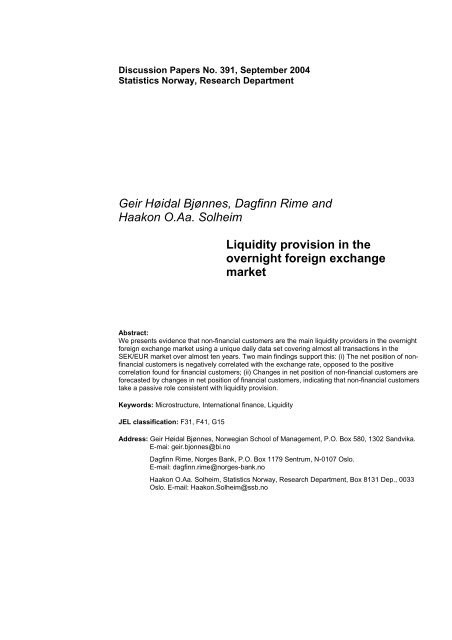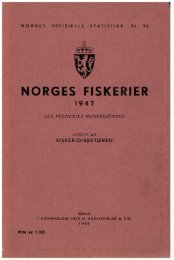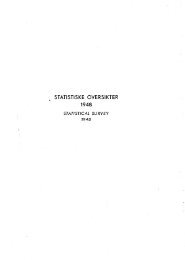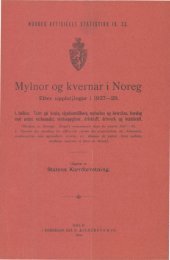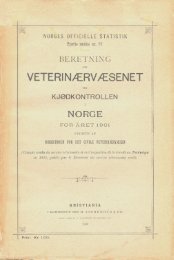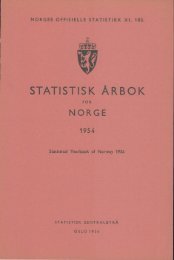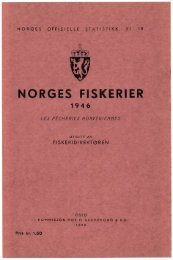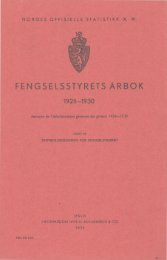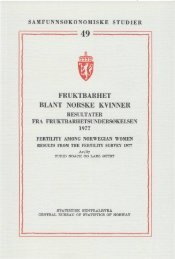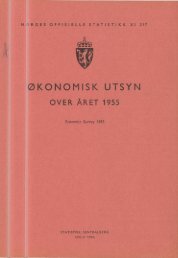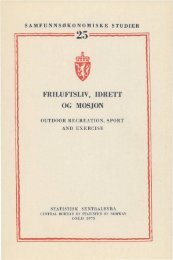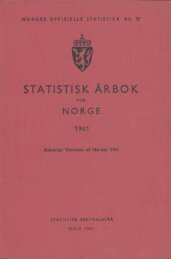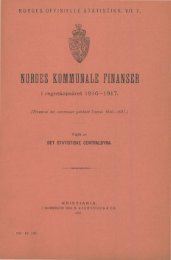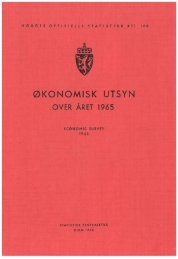Liquidity provision in the overnight foreign exchange market
Liquidity provision in the overnight foreign exchange market
Liquidity provision in the overnight foreign exchange market
You also want an ePaper? Increase the reach of your titles
YUMPU automatically turns print PDFs into web optimized ePapers that Google loves.
Discussion Papers No. 391, September 2004<br />
Statistics Norway, Research Department<br />
Geir Høidal Bjønnes, Dagf<strong>in</strong>n Rime and<br />
Haakon O.Aa. Solheim<br />
<strong>Liquidity</strong> <strong>provision</strong> <strong>in</strong> <strong>the</strong><br />
<strong>overnight</strong> <strong>foreign</strong> <strong>exchange</strong><br />
<strong>market</strong><br />
Abstract:<br />
We presents evidence that non-f<strong>in</strong>ancial customers are <strong>the</strong> ma<strong>in</strong> liquidity providers <strong>in</strong> <strong>the</strong> <strong>overnight</strong><br />
<strong>foreign</strong> <strong>exchange</strong> <strong>market</strong> us<strong>in</strong>g a unique daily data set cover<strong>in</strong>g almost all transactions <strong>in</strong> <strong>the</strong><br />
SEK/EUR <strong>market</strong> over almost ten years. Two ma<strong>in</strong> f<strong>in</strong>d<strong>in</strong>gs support this: (i) The net position of nonf<strong>in</strong>ancial<br />
customers is negatively correlated with <strong>the</strong> <strong>exchange</strong> rate, opposed to <strong>the</strong> positive<br />
correlation found for f<strong>in</strong>ancial customers; (ii) Changes <strong>in</strong> net position of non-f<strong>in</strong>ancial customers are<br />
forecasted by changes <strong>in</strong> net position of f<strong>in</strong>ancial customers, <strong>in</strong>dicat<strong>in</strong>g that non-f<strong>in</strong>ancial customers<br />
take a passive role consistent with liquidity <strong>provision</strong>.<br />
Keywords: Microstructure, International f<strong>in</strong>ance, <strong>Liquidity</strong><br />
JEL classification: F31, F41, G15<br />
Address: Geir Høidal Bjønnes, Norwegian School of Management, P.O. Box 580, 1302 Sandvika.<br />
E-mai: geir.bjonnes@bi.no<br />
Dagf<strong>in</strong>n Rime, Norges Bank, P.O. Box 1179 Sentrum, N-0107 Oslo.<br />
E-mail: dagf<strong>in</strong>n.rime@norges-bank.no<br />
Haakon O.Aa. Solheim, Statistics Norway, Research Department, Box 8131 Dep., 0033<br />
Oslo. E-mail: Haakon.Solheim@ssb.no
Discussion Papers<br />
comprise research papers <strong>in</strong>tended for <strong>in</strong>ternational journals or books. A prepr<strong>in</strong>t of a<br />
Discussion Paper may be longer and more elaborate than a standard journal article, as it<br />
may <strong>in</strong>clude <strong>in</strong>termediate calculations and background material etc.<br />
Abstracts with downloadable Discussion Papers<br />
<strong>in</strong> PDF are available on <strong>the</strong> Internet:<br />
http://www.ssb.no<br />
http://ideas.repec.org/s/ssb/dispap.html<br />
For pr<strong>in</strong>ted Discussion Papers contact:<br />
Statistics Norway<br />
Sales- and subscription service<br />
NO-2225 Kongsv<strong>in</strong>ger<br />
Telephone: +47 62 88 55 00<br />
Telefax: +47 62 88 55 95<br />
E-mail: Salg-abonnement@ssb.no
1 Introduction<br />
The <strong>provision</strong> of liquidity is important for well-function<strong>in</strong>g asset <strong>market</strong>s. Liquid <strong>market</strong>s<br />
match counterparties well (immediacy), have low transaction costs (tight spreads),<br />
and are less volatile (O’Hara, 1995).<br />
In this paper, we study liquidity <strong>provision</strong> <strong>in</strong> <strong>the</strong> <strong>foreign</strong> <strong>exchange</strong> <strong>market</strong>. A central<br />
question raised is <strong>the</strong> follow<strong>in</strong>g: Who is provid<strong>in</strong>g liquidity? The conventional wisdom<br />
is that <strong>market</strong> mak<strong>in</strong>g banks are <strong>the</strong> ma<strong>in</strong> liquidity providers <strong>in</strong> float<strong>in</strong>g <strong>exchange</strong> rate<br />
regimes. However, from <strong>the</strong> studies by Lyons (1995) and Bjønnes and Rime (2004)<br />
we know that dealers of <strong>market</strong> mak<strong>in</strong>g banks have only limited <strong>overnight</strong> positions<br />
and cannot be expected to take last<strong>in</strong>g open positions. Hence, <strong>market</strong> mak<strong>in</strong>g banks<br />
provide liquidity <strong>in</strong>traday, but are less likely to provide liquidity on longer horizons.<br />
In this paper, we empirically <strong>in</strong>vestigate whe<strong>the</strong>r <strong>the</strong>re is a particular group of <strong>market</strong><br />
participants that act as liquidity providers <strong>overnight</strong>. To address this question, we use<br />
a unique data set from <strong>the</strong> Swedish krona (SEK) <strong>market</strong> that conta<strong>in</strong>s observations of<br />
90-95% of all transactions <strong>in</strong> five different <strong>in</strong>struments on a day-to-day basis from <strong>the</strong><br />
beg<strong>in</strong>n<strong>in</strong>g of 1993 up to <strong>the</strong> summer of 2002.<br />
The study of liquidity <strong>in</strong> <strong>the</strong> <strong>foreign</strong> <strong>exchange</strong> <strong>market</strong> is particularly <strong>in</strong>terest<strong>in</strong>g for<br />
at least two reasons. First, our understand<strong>in</strong>g of <strong>the</strong> movements of float<strong>in</strong>g <strong>exchange</strong><br />
rates is ra<strong>the</strong>r poor, and better knowledge of how <strong>the</strong> <strong>market</strong> works may improve our<br />
understand<strong>in</strong>g. Second, as a largely unregulated <strong>market</strong>, patterns of liquidity <strong>provision</strong><br />
have evolved endogenously. This is <strong>in</strong> contrast to several equity <strong>market</strong>s where, e.g.,<br />
<strong>market</strong> makers have obligations to provide liquidity. Daníelsson and Payne (2002) study<br />
<strong>in</strong>traday liquidity <strong>in</strong> an electronic FX order book. The present paper is to <strong>the</strong> best of our<br />
knowledge <strong>the</strong> first to study liquidity <strong>in</strong> a longer perspective for <strong>the</strong> <strong>foreign</strong> <strong>exchange</strong><br />
1
<strong>market</strong>.<br />
Our data allow us to dist<strong>in</strong>guish between four dist<strong>in</strong>ct groups of <strong>market</strong> participants:<br />
(i) Market mak<strong>in</strong>g banks; (ii) F<strong>in</strong>ancial customers; (iii) Non-F<strong>in</strong>ancial customers; and<br />
(iv) <strong>the</strong> Central Bank (Sveriges Riksbank). Currently <strong>the</strong>re is no o<strong>the</strong>r data set on <strong>the</strong><br />
<strong>foreign</strong> <strong>exchange</strong> <strong>market</strong> that gives such broad overview of <strong>the</strong> trad<strong>in</strong>g of a s<strong>in</strong>gle currency.<br />
A notable feature of our data is that <strong>the</strong> flows of different customers (F<strong>in</strong>ancial,<br />
Non-F<strong>in</strong>ancial, and <strong>the</strong> Central Bank), will equal <strong>the</strong> flow of Market mak<strong>in</strong>g banks. 1<br />
If flows of one group of participants are positively correlated with changes <strong>in</strong> <strong>the</strong> <strong>foreign</strong><br />
<strong>exchange</strong> rate, we will see a negative correlation for ano<strong>the</strong>r group, or groups, of<br />
participants.<br />
How can we identify <strong>the</strong> liquidity provider? The <strong>the</strong>ory of <strong>market</strong> mak<strong>in</strong>g predicts<br />
that a positive demand shock (i.e., a purchase by <strong>the</strong> aggressive part <strong>in</strong> <strong>the</strong> trade)<br />
will lead <strong>the</strong> <strong>market</strong> maker to revise prices upwards, hence a positive contemporaneous<br />
correlation between <strong>the</strong> trad<strong>in</strong>g decision of <strong>the</strong> aggressive part and <strong>the</strong> change of <strong>the</strong> <strong>exchange</strong><br />
rate. 2 The supplier of <strong>the</strong> asset, e.g., a <strong>market</strong> maker, will fill <strong>the</strong> role of liquidity<br />
provider. There are <strong>in</strong> particular two characteristics of liquidity providers: (a) The net<br />
flow of liquidity providers will be negatively correlated with <strong>the</strong> change <strong>in</strong> <strong>the</strong> value of<br />
<strong>the</strong> currency; and (b) <strong>Liquidity</strong> providers match o<strong>the</strong>rs’ demand and supply passively.<br />
These two predictions are borne out <strong>in</strong> <strong>the</strong> data. Our f<strong>in</strong>d<strong>in</strong>gs suggest that Non-<br />
F<strong>in</strong>ancial customers are <strong>the</strong> ma<strong>in</strong> liquidity providers <strong>overnight</strong>. First, we f<strong>in</strong>d a negative<br />
correlation between <strong>the</strong> net purchases of <strong>foreign</strong> currency made by Non-F<strong>in</strong>ancial customers<br />
and changes <strong>in</strong> <strong>the</strong> <strong>exchange</strong> rate. This negative correlation is matched by a<br />
1 We use <strong>the</strong> term “flow” for changes <strong>in</strong> position.<br />
2 Us<strong>in</strong>g <strong>the</strong> term<strong>in</strong>ology of microstructure, a purchase by <strong>the</strong> aggressive part <strong>in</strong> <strong>the</strong> trade is a positive<br />
order flow, while a sale is negative. We use <strong>the</strong> phrase “aggressive part” <strong>in</strong>stead of “<strong>in</strong>itiator” or “aggressor”<br />
which is more common <strong>in</strong> microstructure, because a non-<strong>market</strong> mak<strong>in</strong>g liquidity provider may also<br />
“<strong>in</strong>itiate” trades. Strictly speak<strong>in</strong>g, only <strong>market</strong> makers do not <strong>in</strong>itiate trades.<br />
2
positive correlation between net purchases of F<strong>in</strong>ancial customers and changes <strong>in</strong> <strong>the</strong><br />
<strong>exchange</strong> rate. The coefficients of <strong>the</strong> two groups are not only similar <strong>in</strong> absolute value,<br />
but is also very stable. These f<strong>in</strong>d<strong>in</strong>gs lead us to conclude that <strong>the</strong> Non-F<strong>in</strong>ancial customers<br />
we observe fulfill requirement (a) above, while F<strong>in</strong>ancial customers do not. The<br />
fact that <strong>the</strong> <strong>foreign</strong> <strong>exchange</strong> rate and positions held by F<strong>in</strong>ancial and Non-F<strong>in</strong>ancial<br />
customers are co<strong>in</strong>tegrated suggest that <strong>the</strong> price effect is permanent.<br />
Second, requirement (b), that <strong>the</strong> presumed liquidity providers passively match<br />
changes <strong>in</strong> <strong>the</strong> demand and supply of o<strong>the</strong>rs, is tested us<strong>in</strong>g Granger causality. We f<strong>in</strong>d<br />
that <strong>the</strong> trad<strong>in</strong>g of F<strong>in</strong>ancial customers tends to forecast <strong>the</strong> trad<strong>in</strong>g of Non-F<strong>in</strong>ancial<br />
customers. This suggests that <strong>the</strong> Non-F<strong>in</strong>ancial customer group is not <strong>in</strong> <strong>the</strong> active end<br />
of trad<strong>in</strong>g.<br />
These results are not obvious. Four important issues might come to m<strong>in</strong>d. First,<br />
if <strong>the</strong>se are liquidity effects, how can <strong>the</strong>y be permanent? It is important to remember<br />
that it is not liquidity effects that cause <strong>the</strong> change <strong>in</strong> <strong>the</strong> <strong>exchange</strong> rate. The <strong>exchange</strong><br />
rate change is due to a portfolio shock by <strong>the</strong> F<strong>in</strong>ancial customers. We identify <strong>the</strong> supply<br />
of liquidity that meets this portfolio shock (more on <strong>the</strong> economic <strong>in</strong>tuition for <strong>the</strong><br />
permanent effect below). Second, it might seem counter-<strong>in</strong>tuitive that Non-F<strong>in</strong>ancial<br />
customers should provide liquidity. However, one should note that Non-F<strong>in</strong>ancial customers<br />
<strong>in</strong> our data behave like profit-takers; <strong>the</strong>y react to a change <strong>in</strong> <strong>the</strong> <strong>exchange</strong> rate.<br />
A liquidity provider, as used here, is one who enters <strong>the</strong> <strong>market</strong> as a reaction to <strong>the</strong><br />
action of o<strong>the</strong>rs. It is not necessary for <strong>the</strong> Non-F<strong>in</strong>ancial to perceive <strong>the</strong>mselves as<br />
liquidity providers.<br />
Third, it is clear that <strong>the</strong> group of F<strong>in</strong>ancial customers must be very diversified. It<br />
should conta<strong>in</strong> a spectrum of customers from hedge funds to portfolio managers. Especially<br />
hedge funds might use a range of trad<strong>in</strong>g strategies. If anyth<strong>in</strong>g, this could weaken<br />
3
our f<strong>in</strong>d<strong>in</strong>gs relative to a data set were we could identify hedge funds specifically. Last,<br />
if Non-F<strong>in</strong>ancial behave like profit-takers, are <strong>the</strong>y <strong>the</strong>n “Friedman speculators”? The<br />
positions of a Friedman speculator will be negatively correlated with <strong>the</strong> <strong>exchange</strong> rate<br />
when <strong>the</strong> level is mov<strong>in</strong>g away from equilibrium, while <strong>the</strong> positions will be positively<br />
correlated with <strong>the</strong> <strong>exchange</strong> when <strong>the</strong> rate is mov<strong>in</strong>g towards <strong>the</strong> equilibrium level.<br />
Hence, <strong>the</strong> liquidity providers do not necessarily act as “Friedman speculators.”<br />
Closest <strong>in</strong> spirit to this paper are those by Froot and Ramadorai (2002) and Fan and<br />
Lyons (2003). Froot and Ramadorai (2002) have data from <strong>the</strong> global custodian State<br />
Street Corporation, cover<strong>in</strong>g transactions over a period of seven years <strong>in</strong> 111 currencies.<br />
Given <strong>the</strong> source of <strong>the</strong> data, it is reasonable to believe that <strong>the</strong> transactions are<br />
those of f<strong>in</strong>ancial customers. Fan and Lyons (2003) use data on customer trad<strong>in</strong>g from<br />
Citibank. Both studies f<strong>in</strong>d results similar to ours for f<strong>in</strong>ancial customers. While <strong>the</strong><br />
data employed by Froot and Ramadorai (2002) and Fan and Lyons (2003) only represent<br />
a small <strong>market</strong> share of total currency transactions <strong>in</strong> a currency, our data reflect<br />
entire <strong>market</strong> activity. Also <strong>in</strong> contrast to <strong>the</strong>se studies, our data allow us to directly<br />
test how flows of different groups of customers are related to changes <strong>in</strong> <strong>the</strong> <strong>foreign</strong><br />
<strong>exchange</strong> rate.<br />
To give a brief <strong>the</strong>oretical <strong>in</strong>terpretation of our results, we may consider <strong>the</strong> model<br />
by Evans and Lyons (2002). A trad<strong>in</strong>g day is split <strong>in</strong>to three trad<strong>in</strong>g rounds. In <strong>the</strong> first<br />
round, <strong>market</strong> mak<strong>in</strong>g banks provide liquidity to customers. To offload <strong>the</strong>ir <strong>in</strong>ventories<br />
after trad<strong>in</strong>g with non-bank customers <strong>in</strong> round 1, dealers trade among <strong>the</strong>mselves <strong>in</strong><br />
round 2. However, if <strong>the</strong>re is excess demand for one currency after <strong>the</strong> round of <strong>in</strong>terdealer<br />
trad<strong>in</strong>g, <strong>the</strong> <strong>market</strong> mak<strong>in</strong>g banks must <strong>in</strong>duce <strong>the</strong> customers to hold this. The<br />
customers <strong>in</strong> round 3 <strong>the</strong>n need a risk premium to be will<strong>in</strong>g to change <strong>the</strong>ir portfolio<br />
hold<strong>in</strong>gs. Hence, one expects to see a positive correlation between round 1 excess<br />
4
demand for a currency and <strong>the</strong> value of this currency. Us<strong>in</strong>g data from <strong>the</strong> <strong>in</strong>terdealer<br />
<strong>market</strong>, Evans and Lyons (2002) f<strong>in</strong>d strong empirical support for such a positive correlation.<br />
In <strong>the</strong> Evans and Lyons (2002) model, <strong>market</strong> mak<strong>in</strong>g banks provide liquidity <strong>in</strong>traday<br />
to round 1 customers, while round 3 customers are compensated for provid<strong>in</strong>g<br />
<strong>overnight</strong> liquidity. In this model net purchases of all customers sum to zero after <strong>the</strong><br />
third round of trad<strong>in</strong>g. However, this does not mean that net purchases of a particular<br />
group of customers must sum to zero. In light of <strong>the</strong> Evans and Lyons (2002) model, it<br />
is possible to <strong>in</strong>terpret our results such that <strong>the</strong> typical aggressive round 1 customer is<br />
f<strong>in</strong>ancial, while <strong>the</strong> typical liquidity provid<strong>in</strong>g round 3 customer is non-f<strong>in</strong>ancial.<br />
Our results also have implications for <strong>the</strong> <strong>exchange</strong> rate determ<strong>in</strong>ation puzzle (see,<br />
e.g., Meese and Rogoff, 1983; Frankel and Rose, 1995). A better understand<strong>in</strong>g of <strong>the</strong><br />
role played by different <strong>market</strong> participants may be necessary to understand <strong>the</strong> movements<br />
of <strong>exchange</strong> rates. We document co<strong>in</strong>tegration between <strong>the</strong> <strong>exchange</strong> rate and net<br />
currency positions held by F<strong>in</strong>ancial and Non-F<strong>in</strong>ancial customers, which suggests that<br />
price effects are permanent. We also show that net flows are able to expla<strong>in</strong> changes<br />
<strong>in</strong> <strong>the</strong> <strong>foreign</strong> <strong>exchange</strong> rate at frequencies commonly used <strong>in</strong> tests of macroeconomic<br />
models. The explanatory power is very good. Flows by F<strong>in</strong>ancial or Non-F<strong>in</strong>ancial customers<br />
comb<strong>in</strong>ed with <strong>in</strong>terest rate differentials expla<strong>in</strong> roughly 70% of changes <strong>in</strong> <strong>the</strong><br />
<strong>foreign</strong> <strong>exchange</strong> rate at <strong>the</strong> 90-day horizon. As mentioned, <strong>the</strong> coefficient for <strong>the</strong> net<br />
flow of F<strong>in</strong>ancial or Non-F<strong>in</strong>ancial customers is also remarkably stable over <strong>the</strong> sample.<br />
The paper is organized as follows. Section 2 discusses liquidity <strong>provision</strong> <strong>in</strong> FX<br />
<strong>market</strong>s. Our data is presented <strong>in</strong> Section 3. Section 4 reports <strong>the</strong> results on our attempts<br />
to identify <strong>the</strong> liquidity provider. Section 5 provides a discussion of our results, while<br />
Section 6 concludes.<br />
5
2 <strong>Liquidity</strong> <strong>provision</strong> <strong>in</strong> FX <strong>market</strong>s<br />
FX dealers provide liquidity by offer<strong>in</strong>g bid and ask quotes to o<strong>the</strong>r dealers or non-bank<br />
customers. The aggressive part <strong>in</strong> a trade buys at <strong>the</strong> ask and sells at <strong>the</strong> bid (ask ><br />
bid). Microstructure models predict that a buy <strong>in</strong>itiative will <strong>in</strong>crease price, while a sell<br />
<strong>in</strong>itiative will decrease price. Two ma<strong>in</strong> branches of models give different explanations<br />
for this. Inventory control models (e.g., Amihud and Mendelson, 1980; Ho and Stoll,<br />
1981) focus on how risk-averse dealers adjust prices to control <strong>the</strong>ir <strong>in</strong>ventory of an<br />
asset. In <strong>the</strong>se models, a purchase by <strong>the</strong> aggressive trader will push up prices because<br />
<strong>the</strong> dealer typically will <strong>in</strong>crease price to attract sellers when his <strong>in</strong>ventory is smaller<br />
than desired. This effect is only temporary. When <strong>the</strong> dealer has reached his target <strong>in</strong>ventory,<br />
<strong>the</strong> effect disappears. Information-based models (e.g., Kyle, 1985; Glosten and<br />
Milgrom, 1985) consider learn<strong>in</strong>g and adverse selection problems when some <strong>market</strong><br />
participants have private <strong>in</strong>formation. When a dealer receives a trade, he will revise his<br />
expectations (upward <strong>in</strong> <strong>the</strong> case of a buy order and downward <strong>in</strong> <strong>the</strong> case of a sell order)<br />
and set spreads to protect himself aga<strong>in</strong>st <strong>in</strong>formed traders. The <strong>in</strong>formation effect<br />
is permanent. The microstructure <strong>the</strong>ory predicts that <strong>the</strong> flow by <strong>the</strong> aggressive trader<br />
will be positively correlated with contemporaneous price changes. Flows of liquidity<br />
providers, however, is expected to be negatively correlated with contemporaneous price<br />
changes.<br />
Dealers provide liquidity <strong>in</strong> <strong>the</strong> FX <strong>market</strong>, but mostly <strong>in</strong>traday. Dealers usually do<br />
not take large <strong>overnight</strong> positions (see Lyons, 1995; Bjønnes and Rime, 2004). This<br />
means that dealers will offload most of <strong>the</strong>ir <strong>in</strong>ventories to non-bank customers before<br />
<strong>the</strong>y end <strong>the</strong> day. 3 Can we expect any particular group of <strong>market</strong> participants to system-<br />
3 Mean reversion <strong>in</strong> dealer <strong>in</strong>ventories is much faster <strong>in</strong> FX <strong>market</strong>s than <strong>in</strong> equity <strong>market</strong>s (Bjønnes<br />
and Rime, 2004).<br />
6
atically fill <strong>the</strong> role of <strong>overnight</strong> liquidity provider?<br />
Evans and Lyons (2002) develop a model with three trad<strong>in</strong>g rounds each day. Before<br />
quot<strong>in</strong>g <strong>in</strong> round 1, all dealers receive public (macroeconomic) <strong>in</strong>formation r (R =<br />
∑ t r τ ). After quot<strong>in</strong>g <strong>in</strong> round 1 (P i1 = P 1 because all dealers have <strong>the</strong> same <strong>in</strong>formation),<br />
each of <strong>the</strong> N dealers receives <strong>market</strong> orders from his own customers that aggregates <strong>in</strong>to<br />
( )<br />
c 1 ∑<br />
N<br />
i=1 c i1 . A dealer’s customer order is not observed by o<strong>the</strong>r dealers, and hence are<br />
private <strong>in</strong>formation.<br />
Round 2 is <strong>the</strong> <strong>in</strong>terdealer trad<strong>in</strong>g round. After quot<strong>in</strong>g <strong>in</strong> round 2 (dealers do not<br />
want to reveal <strong>the</strong>ir <strong>in</strong>formation, hence P i2 = P 2 ), <strong>the</strong> dealers trade among <strong>the</strong>mselves<br />
to share <strong>in</strong>ventory risk and to speculate on <strong>the</strong>ir (private) <strong>in</strong>formation from <strong>the</strong>ir round<br />
1 customer trades. Net <strong>in</strong>terdealer trades <strong>in</strong>itiated by dealer i (T i2 ) is proportional to his<br />
customer orders <strong>in</strong> round 1 (T i2 = γc i1 ). At <strong>the</strong> close of round 2, all dealers observe<br />
<strong>the</strong> net <strong>in</strong>terdealer order flow (x = ∑ N i=1 T i2). The order flows <strong>in</strong> <strong>the</strong> <strong>in</strong>terdealer trad<strong>in</strong>g<br />
mirrors <strong>the</strong> customer trad<strong>in</strong>g <strong>in</strong> round 1. In FX <strong>market</strong>s, dealers obta<strong>in</strong> estimates of<br />
<strong>in</strong>terdealer order flows from <strong>the</strong> brokers.<br />
In round 3, dealers use <strong>in</strong>formation on net <strong>in</strong>terdealer order flow <strong>in</strong> round 2 to set<br />
prices such that <strong>the</strong> public will<strong>in</strong>gly absorbs all dealer imbalances. To set <strong>the</strong> round 3<br />
price, dealers need to know (i) <strong>the</strong> total flow that <strong>the</strong> public needs to absorb, which <strong>the</strong>y<br />
learn by observ<strong>in</strong>g x, and (ii) <strong>the</strong> public’s risk-bear<strong>in</strong>g capacity. If dealers (on average)<br />
are long <strong>in</strong> dollars, <strong>the</strong>y must reduce <strong>the</strong> price for dollars to <strong>in</strong>duce customers to buy<br />
dollars. The round 3 price is<br />
P i3 = P 3 = P 2 + βx, (1)<br />
where β is some constants depend<strong>in</strong>g on <strong>the</strong> customers’ demand and <strong>the</strong> dealers’ trad<strong>in</strong>g<br />
strategy.<br />
7
If customers net buy, e.g., euros <strong>in</strong> round 1, <strong>the</strong> aggregate <strong>in</strong>terdealer order flow<br />
observed at <strong>the</strong> end of round 2 will be positive because dealers try to buy back euros.<br />
S<strong>in</strong>ce dealers lay off all <strong>the</strong>ir <strong>in</strong>ventories dur<strong>in</strong>g round 3, this means that aggregate<br />
customer orders <strong>in</strong> round 1 and round 3 must be of similar size and with opposite sign.<br />
We thus have<br />
c 1 = 1 γ x = −c 3. (2)<br />
Evans and Lyons (2002) test <strong>the</strong>ir model us<strong>in</strong>g data on <strong>in</strong>terest rates and order flows<br />
from <strong>the</strong> <strong>in</strong>terdealer <strong>market</strong>. They show that <strong>the</strong> <strong>in</strong>terdealer flows can expla<strong>in</strong> a large<br />
proportion of daily changes <strong>in</strong> <strong>foreign</strong> <strong>exchange</strong> rates (JPY/USD and DEM/USD). Without<br />
customer data <strong>the</strong>y are not able to exam<strong>in</strong>e <strong>the</strong> trad<strong>in</strong>g <strong>in</strong> round 1 and 3 directly. So<br />
far, this trad<strong>in</strong>g is a black box.<br />
In this paper, we focus on round 1 and 3. If <strong>the</strong> typical round 1 customer is different<br />
from <strong>the</strong> typical round 3 customer, we may say that different types of customers<br />
fill different roles. Round 1 customers are <strong>the</strong> active ones because <strong>the</strong>y are first and<br />
because <strong>the</strong>y are responsible for <strong>the</strong> dealers’ <strong>in</strong>ventory imbalances. Round 3 customers<br />
are passive because <strong>the</strong>y absorb <strong>the</strong> dealers’ imbalances.<br />
It is important to understand that <strong>the</strong> Evans-Lyons model is a very stylized description<br />
of <strong>the</strong> <strong>foreign</strong> <strong>exchange</strong> <strong>market</strong>. In <strong>the</strong> real-world, trad<strong>in</strong>g takes place cont<strong>in</strong>uously.<br />
At any po<strong>in</strong>t throughout <strong>the</strong> trad<strong>in</strong>g day, dealers can trade with one ano<strong>the</strong>r and receive<br />
customer orders. Customer trades are executed with a wide bid/ask spread. Some<br />
dealers will want to close out immediately <strong>the</strong> positions that results from execut<strong>in</strong>g a<br />
customer order, earn<strong>in</strong>g money on <strong>the</strong> bid/ask spread. O<strong>the</strong>r dealers will speculate on<br />
<strong>in</strong>traday price movement. If <strong>the</strong>re is excess supply or demand for a currency, which<br />
means that dealers as a whole are not will<strong>in</strong>g to keep <strong>the</strong> net position of a currency,<br />
8
dealers will adjust <strong>the</strong>ir prices. When adjust<strong>in</strong>g prices up or down, some customers will<br />
be <strong>in</strong>duced to place orders because <strong>the</strong>y f<strong>in</strong>d <strong>the</strong> price attractive, and thus absorb some<br />
of <strong>the</strong> excess supply or demand. Eventually, <strong>the</strong> price of <strong>the</strong> currency has adjusted to a<br />
level such that dealers as a whole are will<strong>in</strong>g to hold <strong>the</strong>ir rema<strong>in</strong><strong>in</strong>g positions <strong>overnight</strong>.<br />
The price may <strong>in</strong>deed have adjusted to a price where dealers as a whole have a zero net<br />
position.<br />
An alternative to <strong>the</strong> first round-third round framework may be to th<strong>in</strong>k of <strong>the</strong> different<br />
customers as ei<strong>the</strong>r push<strong>in</strong>g <strong>the</strong> <strong>market</strong> or be<strong>in</strong>g pulled by <strong>the</strong> <strong>market</strong>. 4<br />
Pushcustomers<br />
<strong>in</strong>itiate price rises or falls through <strong>the</strong>ir net buy or sell orders. Their trad<strong>in</strong>g<br />
will be positively correlated with price movements. Pull-customers are customers that<br />
are attracted <strong>in</strong>to <strong>the</strong> <strong>market</strong> by prices which suit <strong>the</strong>m because <strong>the</strong>y wish to trade on a<br />
certa<strong>in</strong> side of <strong>the</strong> <strong>market</strong> and decide to act now ra<strong>the</strong>r than postpone <strong>the</strong> trade <strong>in</strong> <strong>the</strong><br />
hope of achiev<strong>in</strong>g a better price. Their trad<strong>in</strong>g will be negatively correlated with price<br />
movements.<br />
3 Data from <strong>the</strong> Swedish krona vs. euro <strong>market</strong><br />
The Riksbank receives daily reports from a number of Swedish and <strong>foreign</strong> banks (primary<br />
dealers or <strong>market</strong> makers, ten as of spr<strong>in</strong>g 2002) on <strong>the</strong>ir buy<strong>in</strong>g and sell<strong>in</strong>g of<br />
five different <strong>in</strong>struments (spot, forward, short swap, standard swap and option). In our<br />
sample, stretch<strong>in</strong>g from January 1993 to June 28, 2002, a total of 27 report<strong>in</strong>g banks are<br />
represented. Only five banks are represented <strong>in</strong> <strong>the</strong> whole sample, and <strong>the</strong>re are never<br />
more than 15 at any po<strong>in</strong>t of time. The report<strong>in</strong>g banks are anonymized, but we know<br />
whe<strong>the</strong>r <strong>the</strong>y are Swedish or <strong>foreign</strong>. The two largest Swedish banks conduct about<br />
4 We are grateful to professor Mark P. Taylor for suggest<strong>in</strong>g <strong>the</strong> terms “push”- and “pull”-customers.<br />
9
43% of all gross trad<strong>in</strong>g <strong>in</strong> <strong>the</strong> <strong>market</strong>. The reported series is an aggregate of Swedish<br />
krona (SEK) trad<strong>in</strong>g aga<strong>in</strong>st all o<strong>the</strong>r currencies, measured <strong>in</strong> krona, and covers 90–95%<br />
of all worldwide trad<strong>in</strong>g <strong>in</strong> SEK. Close to 100% of all <strong>in</strong>terdealer trad<strong>in</strong>g and 80–90%<br />
of customer trad<strong>in</strong>g are <strong>in</strong> SEK/EUR. In our analysis we will <strong>the</strong>refore focus on <strong>the</strong><br />
SEK/EUR <strong>exchange</strong> rate.<br />
Aggregate volume <strong>in</strong>formation is not available to <strong>the</strong> <strong>market</strong>. Foreign <strong>exchange</strong> <strong>market</strong>s<br />
are organized as multiple dealer <strong>market</strong>s, and have low transparency. The specific<br />
reporter only knows his own volume and a noisy signal on aggregate volume that its<br />
receive through brokers. Report<strong>in</strong>g banks obta<strong>in</strong> some statistical summaries of volume<br />
aggregates from <strong>the</strong> Riksbank, but only with a considerable lag. The data set used <strong>in</strong><br />
this paper is not available to <strong>market</strong> participants.<br />
The trades of a Market mak<strong>in</strong>g bank i (MM i ) can be divided <strong>in</strong>to (i) trades with<br />
o<strong>the</strong>r Market mak<strong>in</strong>g banks (MM −trade), (ii) trades with F<strong>in</strong>ancial customers (FIN),<br />
(iii) trades with Non-F<strong>in</strong>ancial customers (NON − FIN), and (iv) trades with Sveriges<br />
Riksbank (CB). The sum of this trad<strong>in</strong>g will amount to <strong>the</strong> change <strong>in</strong> <strong>the</strong> currency<br />
position (flow) of <strong>the</strong> Market mak<strong>in</strong>g bank. Throughout, we will let <strong>the</strong>se names <strong>in</strong>dicate<br />
net positions, where accumulation of flows beg<strong>in</strong>s January 2, 1993. By def<strong>in</strong>ition we<br />
have<br />
∆(MM − T RADE) i + ∆(FIN) i + ∆(NON − FIN) i + ∆CB i = −∆MM i , (3)<br />
where all positions are measured as a more positive number if hold<strong>in</strong>gs of <strong>foreign</strong> currency<br />
<strong>in</strong>crease.<br />
Our data also let us know whe<strong>the</strong>r a counterparty is Swedish or <strong>foreign</strong>. In this<br />
paper, nationality is not an important dist<strong>in</strong>ction when address<strong>in</strong>g our research question.<br />
10
In <strong>the</strong> traditional portfolio balance model, however, <strong>the</strong> focus is on nationality. This is<br />
probably ma<strong>in</strong>ly a reflection of data availability. As <strong>the</strong>re has been no data on actual<br />
currency transactions, researchers have used <strong>the</strong> current account as a proxy for portfolio<br />
shifts over time. As we have data on currency transactions, we need not consider this<br />
limitation. However, we do test for <strong>the</strong> importance of nationality as an explanatory<br />
factor <strong>in</strong> our models (see Section 5).<br />
Swedish Market makers have 74% of <strong>the</strong> F<strong>in</strong>ancial customers’ trad<strong>in</strong>g and 83% of<br />
<strong>the</strong> Non-F<strong>in</strong>ancial customers’ trad<strong>in</strong>g. The F<strong>in</strong>ancial <strong>market</strong> share of all customer trades<br />
is 60% for our data set (<strong>the</strong> <strong>market</strong> share of Non-F<strong>in</strong>ancial customers is thus 40%).<br />
These numbers are very close to <strong>the</strong> <strong>market</strong> shares reported by <strong>the</strong> triennial statistics<br />
published by <strong>the</strong> Bank for International Settlements for all currency <strong>market</strong>s, <strong>in</strong> which<br />
<strong>the</strong> customer <strong>market</strong> share of F<strong>in</strong>ancial customers has <strong>in</strong>creased from 43% <strong>in</strong> 1992 to<br />
66% <strong>in</strong> 2001. Measured over all years, <strong>the</strong>ir <strong>market</strong> share is 56%. The central bank<br />
is barely present <strong>in</strong> <strong>the</strong> sample, only 0.4% of total trades. Most of <strong>the</strong> transactions by<br />
Sveriges Riksbank <strong>in</strong> our sample are related to Swedish government debt. 5<br />
In this paper we focus on net changes <strong>in</strong> currency positions, or currency risk (for a<br />
discussion of gross flows, see Bjønnes, Rime and Solheim, 2005). How should we measure<br />
currency positions? A swap is by def<strong>in</strong>ition a position that net itself out. In o<strong>the</strong>r<br />
words, we can ignore trad<strong>in</strong>g <strong>in</strong> swaps. Options may conta<strong>in</strong> <strong>in</strong>terest<strong>in</strong>g <strong>in</strong>formation.<br />
However, <strong>the</strong> option <strong>market</strong> <strong>in</strong> SEK is limited. To get a picture of currency positions,<br />
we focus on <strong>the</strong> sum of net spot and forward positions. Only us<strong>in</strong>g spot positions would<br />
give a distorted picture of <strong>the</strong> risk <strong>the</strong> participants are will<strong>in</strong>g to take. Our data shows<br />
a significant negative correlation between spot and forward positions for all types of<br />
5 Our data allows us to separate central bank <strong>in</strong>terventions from o<strong>the</strong>r types of central bank trades. In<br />
our data set, <strong>the</strong>re are only a few episodes with <strong>in</strong>terventions (see Solheim, 2004, for more details).<br />
11
participants. The correlation when measured <strong>in</strong> changes (flows) is about -0.7.<br />
Table 1 presents some descriptive statistics for different groups at <strong>the</strong> 30-day horizon.<br />
None of <strong>the</strong> series are normally distributed. Most of <strong>the</strong> non-normality is due<br />
to skewness. We see that skewness for F<strong>in</strong>ancial and Non-F<strong>in</strong>ancial customers have<br />
opposite signs. Also, <strong>the</strong> standard deviations are of similar size.<br />
Table 1: Descriptive statistics on currency flows at <strong>the</strong> 30-day horizon.<br />
F<strong>in</strong>ancial Non-f<strong>in</strong>. Market Central<br />
customers customers makers bank<br />
Mean -0.56 -0.03 0.36 0.23<br />
Std. Dev. 1.21 1.13 0.73 0.25<br />
Skewness 0.34 -0.29 -0.41 0.12<br />
Kurtosis 3.78 3.19 4.50 3.31<br />
Sample: 1.1994-6.2002. All series are <strong>in</strong> SEK 10 billion.<br />
From Table 1 we see that Market mak<strong>in</strong>g banks (to some extent) tend to accumulate<br />
<strong>foreign</strong> currency (positive mean). To understand this f<strong>in</strong>d<strong>in</strong>g, we should remember that<br />
<strong>the</strong> banks have operations o<strong>the</strong>r than <strong>market</strong> mak<strong>in</strong>g. Market mak<strong>in</strong>g dealers (and <strong>the</strong><br />
proprietary trad<strong>in</strong>g desk) may hold some <strong>overnight</strong> positions, but <strong>the</strong> positions will not<br />
accumulate over time. This currency risk is probably held by <strong>the</strong> customers of <strong>the</strong> bank<br />
through different funds etc. offered by <strong>the</strong> bank. These customers can be both f<strong>in</strong>ancial<br />
or non-f<strong>in</strong>ancial.<br />
Correlations between flows can give a first clue on liquidity <strong>provision</strong>. The correlation<br />
between <strong>the</strong> flows of Market mak<strong>in</strong>g banks and F<strong>in</strong>ancial customers is negative,<br />
as we would expect, at -0.46. Note, however, <strong>the</strong> strong negative correlation, -0.80,<br />
between flows of F<strong>in</strong>ancial and Non-F<strong>in</strong>ancial customers.<br />
Table 2 shows <strong>the</strong> correlation between flows and some macro variables at <strong>the</strong> quarterly<br />
frequency. By consider<strong>in</strong>g <strong>the</strong> quarterly frequency we may <strong>in</strong>clude <strong>the</strong> current<br />
account and <strong>the</strong> trade balance. We see that F<strong>in</strong>ancial customers tend to buy <strong>foreign</strong> cur-<br />
12
ency when <strong>the</strong> bond returns <strong>in</strong> Sweden <strong>in</strong>crease relative to German bond returns (return<br />
on ten-year bonds). For three-month <strong>in</strong>terest rates this relationship is much weaker. We<br />
also see that F<strong>in</strong>ancial customers tend to buy Swedish kroner when <strong>the</strong> return on <strong>the</strong><br />
Swedish stock <strong>market</strong> <strong>in</strong>creases relative to <strong>the</strong> world stock <strong>market</strong>, and <strong>in</strong> particular<br />
when <strong>the</strong> Swedish stock <strong>market</strong> return <strong>in</strong>creases. These stock <strong>market</strong>-FX correlations<br />
are well-known among FX dealers. For measures of <strong>in</strong>flation, current account and <strong>the</strong><br />
trade balance, <strong>the</strong>re are no significant correlations with flows of F<strong>in</strong>ancial customers.<br />
For Non-F<strong>in</strong>ancial customers we f<strong>in</strong>d a negative correlation between changes <strong>in</strong> relative<br />
bond returns and net flows. When <strong>the</strong> relative performance of <strong>the</strong> Swedish stock<br />
<strong>market</strong> <strong>in</strong>creases, Non-F<strong>in</strong>ancial customers tend to sell Swedish kroner. Interest<strong>in</strong>gly,<br />
we see that flows of Non-F<strong>in</strong>ancial customers are heavily correlated with <strong>the</strong> current<br />
account and trade balance. This suggests that, to some extent, <strong>the</strong>se customers can be<br />
characterized as “current account traders.” 6<br />
Table 2: Correlations between changes <strong>in</strong> net hold<strong>in</strong>gs of <strong>foreign</strong> currency and some<br />
macro variables at <strong>the</strong> quarterly horizon<br />
F<strong>in</strong>ancial Non-F<strong>in</strong>ancial Central<br />
customers customers Bank<br />
∆(RDIF10Y) 0.25 -0.13 -0.07<br />
∆(RDIF3M) 0.04 0.04 -0.21<br />
∆(STOCK DIF) -0.25 0.26 -0.25<br />
∆(STOCK SWE) -0.45 0.35 -0.10<br />
∆(CPI SWE-CPI GER) -0.04 0.05 -0.20<br />
Current account 0.01 -0.41 0.35<br />
Trade balance -0.05 -0.36 0.56<br />
Sample: 1.1993-6.2002. Change <strong>in</strong> variable is <strong>in</strong>dicated by “∆.” RDIF10Y is <strong>the</strong> difference between <strong>the</strong> yield to maturity for<br />
Swedish and German bonds with ten years to maturity. Similarly, RDIF3M is <strong>the</strong> difference between Swedish and German 3-month<br />
<strong>in</strong>terest rates. STOCKDIF is <strong>the</strong> difference between <strong>the</strong> return on Swedish and European (ex. Sweden) stock <strong>market</strong> <strong>in</strong>dexes, while<br />
STOCK SW E is <strong>the</strong> return on <strong>the</strong> Swedish stock <strong>market</strong> <strong>in</strong>dex. D(CPI SW E) − D(CPI GER) measures <strong>the</strong> difference between<br />
Swedish and Foreign <strong>in</strong>flation.<br />
While flows of F<strong>in</strong>ancial customers show no significant correlation with <strong>the</strong> cur-<br />
6 We do not mean that <strong>the</strong>ir trades are only related to <strong>the</strong> current account. For <strong>in</strong>stance, Non-F<strong>in</strong>ancial<br />
customers contribute to direct <strong>in</strong>vestments.<br />
13
ent account and <strong>the</strong> trade balance, we see that flows of <strong>the</strong> central bank are positively<br />
correlated with <strong>the</strong> current account and trade balance. This may be expla<strong>in</strong>ed by <strong>the</strong><br />
<strong>in</strong>creased <strong>foreign</strong> borrow<strong>in</strong>g dur<strong>in</strong>g <strong>the</strong> first half of <strong>the</strong> n<strong>in</strong>eties by <strong>the</strong> central bank on<br />
behalf of <strong>the</strong> Swedish Debt Office. Table 2 suggests that Non-F<strong>in</strong>ancial customers are<br />
<strong>the</strong>ir (f<strong>in</strong>al) counterpart <strong>in</strong> <strong>the</strong>se trades (<strong>the</strong> correlation between <strong>the</strong>se flows is -0.28).<br />
4 Empirical results<br />
In this section, we provide our empirical results. First, we test for co<strong>in</strong>tegration between<br />
<strong>the</strong> <strong>foreign</strong> <strong>exchange</strong> rate and positions held by F<strong>in</strong>ancial and Non-F<strong>in</strong>ancial customers<br />
(accumulated flows). Second, we exam<strong>in</strong>e <strong>the</strong> short-run dynamics at different horizons,<br />
from <strong>the</strong> daily to <strong>the</strong> 90-day horizon. We need to establish that <strong>the</strong>re is a systematic<br />
correlation between <strong>the</strong> trad<strong>in</strong>g of a group and <strong>the</strong> <strong>exchange</strong> rate, and that this correlation<br />
is matched (and has <strong>the</strong> opposite sign) for some o<strong>the</strong>r group. Third, to conv<strong>in</strong>ce<br />
<strong>the</strong> reader that <strong>the</strong> data matches <strong>the</strong> <strong>the</strong>oretical predictions about liquidity <strong>provision</strong> we<br />
need to establish that <strong>the</strong> flows of <strong>the</strong> group positively correlated with <strong>the</strong> <strong>exchange</strong> rate<br />
is actually <strong>the</strong> active part of <strong>the</strong> <strong>market</strong> (round 1 player), while <strong>the</strong> group with negative<br />
correlation between <strong>the</strong>ir flows and <strong>the</strong> <strong>exchange</strong> rate is on <strong>the</strong> passive side (round 3<br />
player).<br />
In all regressions, we use <strong>the</strong> log of <strong>the</strong> SEK/EUR measured at close of <strong>the</strong> Swedish<br />
<strong>market</strong> (shown <strong>in</strong> Figure 1). However, such a series is only available start<strong>in</strong>g January<br />
1, 1994. Hence, all regressions beg<strong>in</strong> at this po<strong>in</strong>t. We use <strong>the</strong> 10-year bond yield<br />
differential and <strong>the</strong> 3-month <strong>in</strong>terest rate differential as proxies for macroeconomic<br />
variables.The 10-year differential may capture long-term macroeconomic expectations<br />
while <strong>the</strong> 3-month differential captures short-term expectations.<br />
14
11.0<br />
10.5<br />
10.0<br />
9.5<br />
9.0<br />
8.5<br />
8.0<br />
1994 1995 1996 1997 1998 1999 2000 2001 2002<br />
Figure 1: The SEK/EUR <strong>exchange</strong> rate<br />
Sample: 1.1994-6.2002. Note that for observations prior to January 1, 1999, we use DEM <strong>in</strong>stead of EUR. Before January 1, 1999<br />
<strong>the</strong> majority of SEK trad<strong>in</strong>g was conducted <strong>in</strong> DEM as it is currently conducted <strong>in</strong> EUR.<br />
4.1 Co<strong>in</strong>tegration<br />
The Evans-Lyons model presented <strong>in</strong> Section 2 implies <strong>the</strong> follow<strong>in</strong>g four testable implications,<br />
P t = α<br />
P t = α<br />
P t = α<br />
t<br />
∑<br />
τ=1<br />
t<br />
∑<br />
τ=1<br />
t<br />
∑<br />
τ=1<br />
r τ + β c1<br />
r τ + β x<br />
r τ − β c3<br />
c 1 = x γ = −c 3,<br />
t<br />
∑<br />
τ=1<br />
t<br />
∑ x τ ,<br />
τ=1<br />
t<br />
∑ c 3,τ<br />
τ=1<br />
c 1,τ ,<br />
(4a)<br />
(4b)<br />
(4c)<br />
(4d)<br />
where P is <strong>the</strong> level of <strong>the</strong> <strong>exchange</strong> rate, r is public macroeconomic <strong>in</strong>formation, and<br />
c 1 , x, and c 3 is round 1 customers’ flow, aggregated <strong>in</strong>terdealer order flow, and round<br />
15
3 customers’ flow, respectively. The three first equations are co<strong>in</strong>tegrat<strong>in</strong>g relations<br />
(levels), while <strong>the</strong> fourth describes <strong>the</strong> relation between daily flows. Our data allows estimation<br />
of <strong>the</strong> three relations <strong>in</strong> Eqs. (4a), (4c), and (4d), and our discussion henceforth<br />
will <strong>the</strong>refore refer to <strong>the</strong>se equations. 7<br />
As a set of predictions of a unified <strong>the</strong>ory it is preferable to estimate <strong>the</strong> equations<br />
as a system. The two co<strong>in</strong>tegrat<strong>in</strong>g relations <strong>in</strong> Eqs. (4a) and (4c) cannot, however, be<br />
estimated toge<strong>the</strong>r because <strong>the</strong>y would be expected to be identical. One could <strong>in</strong>stead<br />
estimate one of <strong>the</strong> price relations toge<strong>the</strong>r with <strong>the</strong> relation between daily flows of <strong>the</strong><br />
customers, Eq. (4d). As discussed <strong>in</strong> Section 2, <strong>in</strong> reality <strong>the</strong> flows of <strong>the</strong> customers<br />
will not match perfectly on a day-to-day basis. One implications of this is that Eq. (4d)<br />
should ra<strong>the</strong>r be <strong>in</strong>terpreted as a steady state relation, and hence could be estimated as<br />
part of a co<strong>in</strong>tegrat<strong>in</strong>g system (with positions <strong>in</strong>stead of flows). We <strong>the</strong>refore look at<br />
two equivalent versions of <strong>the</strong> same system. In <strong>the</strong> first version, we estimate <strong>the</strong> price<br />
equation with <strong>the</strong> position of F<strong>in</strong>ancial customers, Eq. (4a), and <strong>the</strong> steady state relation<br />
between <strong>the</strong> two customer groups, Eq. (4d). In <strong>the</strong> second version we replace F<strong>in</strong>ancial<br />
customers with Non-F<strong>in</strong>ancial customers, Eq. (4c).<br />
The co<strong>in</strong>tegrat<strong>in</strong>g equations are estimated us<strong>in</strong>g <strong>the</strong> Johansen method on daily observations.<br />
We <strong>in</strong>clude <strong>the</strong> 3-month and 10-year <strong>in</strong>terest rate differentials <strong>in</strong> <strong>the</strong> estimations.<br />
Interest-differentials are usually assumed to be stationary. However, <strong>in</strong> <strong>the</strong><br />
sample <strong>the</strong>y are clearly non-stationary. Includ<strong>in</strong>g a stationary variable <strong>in</strong> <strong>the</strong> co<strong>in</strong>tegration<br />
framework may affect <strong>the</strong> co<strong>in</strong>tegration tests. On <strong>the</strong> o<strong>the</strong>r hand, treat<strong>in</strong>g a<br />
non-stationary variable, <strong>in</strong> <strong>the</strong> sample, as stationary <strong>in</strong> <strong>the</strong> co<strong>in</strong>tegration framework may<br />
have implications for <strong>the</strong> <strong>in</strong>ference. We <strong>the</strong>refore choose to treat <strong>the</strong> <strong>in</strong>terest variables<br />
7 The co<strong>in</strong>tegration vector with <strong>in</strong>terdealer order flow is, however, analyzed by Killeen, Lyons and<br />
Moore (2004). They f<strong>in</strong>d that <strong>the</strong> predicted properties hold.<br />
16
as non-stationary <strong>in</strong> order to get <strong>the</strong> correct <strong>in</strong>ference.<br />
Unit root tests show that all variables <strong>in</strong> <strong>the</strong> co<strong>in</strong>tegrat<strong>in</strong>g vectors are non-stationary. 8<br />
We only model <strong>the</strong> <strong>exchange</strong> rate and <strong>the</strong> two customer positions <strong>in</strong> <strong>the</strong> VAR, while<br />
<strong>the</strong> o<strong>the</strong>r variables <strong>in</strong> <strong>the</strong> co<strong>in</strong>tegration analysis are restricted to be with<strong>in</strong> <strong>the</strong> vectors.<br />
Differences of <strong>the</strong>se o<strong>the</strong>r variables enter <strong>the</strong> VAR as exogenous.<br />
Panel a) of Table 3 shows <strong>the</strong> f<strong>in</strong>al version of <strong>the</strong> two sets of co<strong>in</strong>tegrat<strong>in</strong>g vectors.<br />
The price equations are normalized on <strong>the</strong> <strong>exchange</strong> rate, while <strong>the</strong> steady state position<br />
equation is normalized on Non-F<strong>in</strong>ancial customers’ position. Panel b) reports <strong>the</strong><br />
error correction terms. The columns refer to <strong>the</strong> co<strong>in</strong>tegrat<strong>in</strong>g vector <strong>in</strong> question, while<br />
<strong>the</strong> rows represent <strong>the</strong> equations <strong>in</strong> <strong>the</strong> VAR where <strong>the</strong> vectors enter. The restrictions<br />
we impose are (a) that ei<strong>the</strong>r F<strong>in</strong>ancial or Non-F<strong>in</strong>ancial positions are excluded from<br />
<strong>the</strong> co<strong>in</strong>tegration vector and (b) that both F<strong>in</strong>ancial and Non-F<strong>in</strong>ancial positions are excluded<br />
from <strong>the</strong> error correction term of <strong>the</strong> equation standardized on <strong>the</strong> <strong>exchange</strong> rate.<br />
All restrictions are found to hold, as reported <strong>in</strong> panel c) of <strong>the</strong> table. 9<br />
From <strong>the</strong> two price relations, columns 2 and 4, we see that <strong>the</strong> two position coefficients<br />
are significant. As expected, F<strong>in</strong>ancial customers act as <strong>the</strong> aggressive traders,<br />
while <strong>the</strong> negative coefficient for <strong>the</strong> Non-F<strong>in</strong>ancial customers is consistent with <strong>the</strong>se<br />
be<strong>in</strong>g liquidity providers. Fur<strong>the</strong>rmore, <strong>the</strong> co<strong>in</strong>tegrat<strong>in</strong>g equations for <strong>the</strong> positions,<br />
columns 3 and 5, show that <strong>the</strong> two groups <strong>in</strong>deed match each o<strong>the</strong>r, as predicted by Eq.<br />
(4d).<br />
The restrictions on <strong>the</strong> error correction term <strong>in</strong>dicate that <strong>the</strong> position of both groups<br />
8 An exception is <strong>the</strong> position of <strong>the</strong> Central Bank. While <strong>the</strong> Augmented Dickey-Fuller test rejects <strong>the</strong><br />
null of unit root at <strong>the</strong> 10%-level, o<strong>the</strong>r tests like <strong>the</strong> Ng-Perron, Kwiatkowski-Phillips-Schmidt-Sh<strong>in</strong>, and<br />
Elliott-Ro<strong>the</strong>nberg-Stock test clearly <strong>in</strong>dicate a unit root. The question is <strong>the</strong>refore unresolved. Exclud<strong>in</strong>g<br />
<strong>the</strong> Central Bank does not seem to affect <strong>the</strong> co<strong>in</strong>tegration tests. All stationarity tests are available from<br />
<strong>the</strong> authors at request.<br />
9 A less restricted version is available from <strong>the</strong> authors at request.<br />
17
Table 3: Co<strong>in</strong>tegration results, daily observations<br />
F<strong>in</strong>ancial<br />
Non-F<strong>in</strong>ancial<br />
a) Co<strong>in</strong>tegration SEK/EUR Non-F<strong>in</strong> pos SEK/EUR Non-F<strong>in</strong> pos<br />
F<strong>in</strong>ancial 0.0092 -1 0 -1<br />
(0.0036) (–) (–) (–)<br />
Non-F<strong>in</strong>ancial 0 -0.0063<br />
(–) (0.0021)<br />
10-year bond diff. 4.83 0 3.52 0<br />
(1.42) (–) (1.36) (–)<br />
3-month diff. -1.89 0 -1.38 0<br />
(1.00) (–) (1.09) (–)<br />
CB-position 0 -1.68 0 -1.83<br />
(–) (0.20) (–) (0.26)<br />
MM-position 0 -0.65 0 -0.53<br />
(–) (0.19) (–) (0.24)<br />
Trend 0.00020 0 0 0<br />
(0.00006) (–) (–) (–)<br />
b) Error correction term<br />
∆SEK/EUR -0.0131 -0.000121 -0.0121 -0.000047<br />
(0.0029) (0.000054) (0.0030) (0.000041)<br />
∆NonF<strong>in</strong>ancial 0 -0.001863 0 -0.001635<br />
(–) (0.000541) (–) (0.000473)<br />
∆F<strong>in</strong>ancial 0 0 0 0<br />
(–) (–) (–) (–)<br />
c) Test Test stat. p-value Test stat. p-value<br />
LR test of restrictions 4.84 0.85 8.09 0.62<br />
No. Observations 2214 2214<br />
Sample: 1.1994-6.2002. Co<strong>in</strong>tegration estimated with <strong>the</strong> Johansen-method. The VAR models <strong>the</strong> <strong>exchange</strong> rate change and <strong>the</strong><br />
flow of <strong>the</strong> two customer groups. The o<strong>the</strong>r variables <strong>in</strong> <strong>the</strong> co<strong>in</strong>tegrat<strong>in</strong>g vectors are not modeled. Differences of <strong>the</strong>se, and one<br />
lag of differences, are <strong>in</strong>cluded <strong>in</strong> <strong>the</strong> VAR. The VAR conta<strong>in</strong>s two lags, determ<strong>in</strong>ed by F-test. Standard errors of coefficients <strong>in</strong><br />
paren<strong>the</strong>sis. The SEK/EUR co<strong>in</strong>tegrat<strong>in</strong>g vectors are normalized on <strong>the</strong> <strong>exchange</strong> rate, while <strong>the</strong> position co<strong>in</strong>tegrat<strong>in</strong>g vectors <strong>in</strong><br />
column Non-F<strong>in</strong> pos are normalized on <strong>the</strong> position of <strong>the</strong> Non-F<strong>in</strong>ancial customers. Co<strong>in</strong>tegration results are reported as if <strong>the</strong><br />
normaliz<strong>in</strong>g variable is a left-hand-side variable. Panel b) reports <strong>the</strong> error correction term. The columns <strong>in</strong>dicate <strong>the</strong> co<strong>in</strong>tegrat<strong>in</strong>g<br />
vector, while <strong>the</strong> rows <strong>in</strong>dicate which equation <strong>in</strong> <strong>the</strong> VAR <strong>the</strong> vector enters. All cells without standard error are <strong>the</strong> result of<br />
restrictions. The test of <strong>the</strong> restrictions is reported <strong>in</strong> panel c).<br />
18
of customers is weakly exogenous to <strong>the</strong> price. This is reasonable, given that we expect<br />
F<strong>in</strong>ancial customers to “push” <strong>the</strong> <strong>market</strong> utiliz<strong>in</strong>g private <strong>in</strong>formation. The fact that <strong>the</strong><br />
effect from <strong>the</strong>ir trad<strong>in</strong>g is positive and persistent is an <strong>in</strong>dication that <strong>the</strong>re <strong>in</strong>deed is an<br />
<strong>in</strong>formation effect. The trend enters significantly <strong>in</strong> <strong>the</strong> price equation for <strong>the</strong> F<strong>in</strong>ancial<br />
customers, but not for <strong>the</strong> Non-F<strong>in</strong>ancial (restricted to zero). Engle and Yoo (1991) suggest<br />
that <strong>the</strong> trend captures o<strong>the</strong>r unobservable variables. If <strong>the</strong> trad<strong>in</strong>g of <strong>the</strong> F<strong>in</strong>ancial<br />
customers are partly driven by <strong>in</strong>formation that has not yet reached <strong>the</strong> <strong>market</strong>, while<br />
<strong>the</strong> Non-F<strong>in</strong>ancial customers act as liquidity providers, we would expect that <strong>the</strong> trend<br />
should enter <strong>the</strong> price equation with <strong>the</strong> position of F<strong>in</strong>ancial customers but not <strong>in</strong> <strong>the</strong><br />
price equation of <strong>the</strong> Non-F<strong>in</strong>ancial customers. The <strong>in</strong>tuition for <strong>the</strong> weak exogeneity<br />
of <strong>the</strong> position of Non-F<strong>in</strong>ancial customers is that <strong>the</strong> banks “pick” price-quantity<br />
comb<strong>in</strong>ations along <strong>the</strong>ir supply curve. One can th<strong>in</strong>k of this as if Non-F<strong>in</strong>ancial customers<br />
placed a limit-order schedule <strong>in</strong> <strong>the</strong> <strong>market</strong> <strong>in</strong> <strong>the</strong> morn<strong>in</strong>g. Weak exogeneity<br />
allows us to run s<strong>in</strong>gle-equation error correction models with contemporaneous flow as<br />
an exogenous variable. We return to this below.<br />
4.2 Regress<strong>in</strong>g <strong>exchange</strong> rate changes on customers’ flows and changes<br />
<strong>in</strong> <strong>in</strong>terest rates<br />
Hav<strong>in</strong>g established that <strong>the</strong>re is a long-term relation between <strong>the</strong> net positions of customers<br />
(accumulated flow) and <strong>the</strong> <strong>exchange</strong> rate, we proceed to look at <strong>the</strong> relation<br />
between net flows (changes <strong>in</strong> net positions) and changes <strong>in</strong> <strong>the</strong> <strong>exchange</strong> rate. The<br />
co<strong>in</strong>tegration analysis established evidence of liquidity <strong>provision</strong> <strong>in</strong> <strong>the</strong> long run. By<br />
study<strong>in</strong>g short-run dynamics we can say someth<strong>in</strong>g about liquidity <strong>provision</strong> <strong>overnight</strong>.<br />
In all regressions, we <strong>in</strong>clude <strong>the</strong> error correction term from <strong>the</strong> co<strong>in</strong>tegration anal-<br />
19
ysis presented above. As <strong>the</strong> two price co<strong>in</strong>tegration vectors are equivalent, we use <strong>the</strong><br />
vector estimated us<strong>in</strong>g Non-F<strong>in</strong>ancial positions, as presented <strong>in</strong> Table 3. Us<strong>in</strong>g <strong>the</strong> price<br />
vector with F<strong>in</strong>ancial positions would not alter any results. To utilize <strong>the</strong> fact that we<br />
have access to daily data, we apply a standard GMM procedure to account for <strong>the</strong> fact<br />
that we have overlapp<strong>in</strong>g observations when we look at changes beyond one day.<br />
Table 4: Flows and returns<br />
5 days 30 days 90 days<br />
coef. t-stat. coef. t-stat. coef. t-stat.<br />
Constant 0.11 4.23 ** 0.49 4.86 ** 1.13 6.57 **<br />
∆F<strong>in</strong>ancial 0.0037 4.02 ** 0.0055 5.41 ** 0.0071 5.30 **<br />
∆RDIF10Y 3.18 12.61 ** 3.08 7.50 ** 2.99 7.13 **<br />
∆RDIF3M 0.80 2.88 ** 0.79 1.79 0.64 1.58<br />
COINT(-n) -0.05 -4.21 ** -0.21 -4.81 ** -0.49 -6.48 **<br />
R 2 0.30 0.50 0.72<br />
5 days 30 days 90 days<br />
coef. t-stat. coef. t-stat. coef. t-stat.<br />
Constant 0.11 4.10 ** 0.48 4.34 ** 1.14 5.85 **<br />
∆Non-F<strong>in</strong>ancial -0.0030 -3.05 ** -0.0052 -4.85 ** -0.0067 -5.03 **<br />
∆RDIF10Y 3.19 12.19 ** 3.22 7.18 ** 3.23 7.05 **<br />
∆RDIF3M 0.83 2.93 ** 0.88 1.83 0.74 1.55<br />
COINT(-n) -0.05 -4.08 ** -0.21 -4.32 ** -0.50 -5.85 **<br />
R 2 0.29 0.48 0.69<br />
Sample: 1.1994-6.2002. The table shows a GMM regression on (log(SEK/EUR) t − log(SEK/EUR t−n ), where n <strong>in</strong>dicate <strong>the</strong><br />
number of days over which we measure <strong>the</strong> return; 5, 30 and 90 days respectively. Similarly, “∆” <strong>in</strong> front of a variable <strong>in</strong>dicates<br />
change from t −n to t. Net positions <strong>in</strong> currency are measured <strong>in</strong> SEK 10 billion. “F<strong>in</strong>ancial” is net positions of F<strong>in</strong>ancial customers,<br />
“Non-F<strong>in</strong>ancial” are net positions of Non-F<strong>in</strong>ancial customers. RDIF10Y is <strong>the</strong> difference between <strong>the</strong> yield to maturity for Swedish<br />
and German bonds with ten years to maturity. Similarly, RDIF3M is <strong>the</strong> difference between Swedish and German 3-month <strong>in</strong>terest<br />
rates. Co<strong>in</strong>t(-n) is <strong>the</strong> error correction term from <strong>the</strong> co<strong>in</strong>tegration analysis.<br />
The co<strong>in</strong>tegration vector is lagged with n periods. Estimations are made us<strong>in</strong>g daily data and overlapp<strong>in</strong>g samples. They are<br />
estimated us<strong>in</strong>g GMM, with a weight<strong>in</strong>g matrix that equals <strong>the</strong> set of exogenous variables, and standard errors are calculated us<strong>in</strong>g<br />
a variable Newey-West bandwidth.<br />
**(*) Statistical significance at <strong>the</strong> 1%(5%) level.<br />
Table 4 reports regressions of changes <strong>in</strong> <strong>the</strong> <strong>foreign</strong> <strong>exchange</strong> rate on currency flows<br />
of F<strong>in</strong>ancial and Non-F<strong>in</strong>ancial customers for <strong>the</strong> 5-day, 30-day and 90-day horizon. As<br />
is clear from Table 4, <strong>the</strong> sign on <strong>the</strong> coefficient for F<strong>in</strong>ancial customers is positive and<br />
significant at all horizons reported. The coefficient <strong>in</strong>creases from 0.37% at <strong>the</strong> 5-day<br />
20
horizon to 0.71% per SEK 10 billion at <strong>the</strong> 90-day horizon. These numbers are economically<br />
significant. For <strong>in</strong>stance, at <strong>the</strong> 30-day horizon <strong>the</strong> standard deviation of currency<br />
flows of F<strong>in</strong>ancial customers is 12 billion SEK. An <strong>in</strong>crease of one standard deviation<br />
<strong>in</strong> <strong>the</strong> net flow of F<strong>in</strong>ancial customers will <strong>the</strong>n, on average, imply an <strong>in</strong>crease <strong>in</strong> <strong>the</strong><br />
<strong>foreign</strong> <strong>exchange</strong> rate of 0.66%. For comparison, <strong>the</strong> standard deviation for changes <strong>in</strong><br />
<strong>the</strong> <strong>foreign</strong> <strong>exchange</strong> rate over <strong>the</strong> 30-day horizon is 2.33%.<br />
The coefficient for <strong>the</strong> error correction term is negative and significant for all horizons<br />
reported. At <strong>the</strong> five-day horizon, return to <strong>the</strong> long-run equilibrium takes place by<br />
5% <strong>in</strong> each period. For <strong>the</strong> 30-day and 90-day horizon, <strong>the</strong> adjustment to <strong>the</strong> long run<br />
equilibrium takes place by 21% and 49% <strong>in</strong> each period, respectively.<br />
The coefficient for changes <strong>in</strong> <strong>the</strong> ten-year <strong>in</strong>terest rate differential is positive and<br />
significant for all time horizons. An <strong>in</strong>crease <strong>in</strong> <strong>the</strong> ten-year <strong>in</strong>terest rate differential may<br />
signal expectations of higher <strong>in</strong>flation <strong>in</strong> Sweden relative to Germany and <strong>the</strong> o<strong>the</strong>r eurocountries.<br />
The strong correlation between <strong>the</strong> <strong>exchange</strong> rate and <strong>the</strong> 10-year <strong>in</strong>terest rate<br />
differential <strong>in</strong> Sweden is well known <strong>in</strong> <strong>the</strong> Swedish <strong>market</strong> and is ma<strong>in</strong>ly due to <strong>the</strong> fact<br />
that when Sweden emerged from recession <strong>in</strong> <strong>the</strong> early 1990’s, <strong>the</strong> <strong>in</strong>terest rate spread<br />
narrowed and <strong>the</strong> <strong>exchange</strong> rate streng<strong>the</strong>ned. The coefficient for changes <strong>in</strong> <strong>the</strong> threemonth<br />
<strong>in</strong>terest rate differential is only significant at <strong>the</strong> five-day horizon. The coefficient<br />
is positive, which means that an <strong>in</strong>creased <strong>in</strong>terest rate differential is consistent with a<br />
depreciat<strong>in</strong>g SEK.<br />
The explanatory power is very good. The regressions expla<strong>in</strong> as much as 30-72% of<br />
all variation <strong>in</strong> <strong>the</strong> dependent variable.<br />
In <strong>the</strong> lower part of Table 4, we replicate <strong>the</strong> estimations, only substitut<strong>in</strong>g flows of<br />
F<strong>in</strong>ancial customers with flows of Non-F<strong>in</strong>ancial customers. As we see, <strong>the</strong> coefficient<br />
for Non-F<strong>in</strong>ancial customers is also highly significant for all time horizons. The co-<br />
21
efficient size changes from -0.30% at <strong>the</strong> 5-day horizon to -0.67% per SEK 10 billion<br />
at a horizon of 90 days. The coefficients for <strong>the</strong> error correction term and <strong>the</strong> macro<br />
variables are similar to those reported for <strong>the</strong> regressions with F<strong>in</strong>ancial customers.<br />
Aga<strong>in</strong>, <strong>the</strong> explanatory power is very good. Between 29% and 69% of all variation <strong>in</strong><br />
<strong>the</strong> dependent variable is expla<strong>in</strong>ed by <strong>the</strong> regressions. Fur<strong>the</strong>rmore, we notice that <strong>the</strong><br />
coefficient for Non-F<strong>in</strong>ancial customers is almost exactly <strong>the</strong> opposite of <strong>the</strong> coefficient<br />
on F<strong>in</strong>ancial customers. This is an <strong>in</strong>dication that Non-F<strong>in</strong>ancial customers also provide<br />
liquidity on shorter horizons.<br />
It is sometimes argued that <strong>the</strong> relation between flows and changes <strong>in</strong> <strong>the</strong> <strong>exchange</strong><br />
rate should be of a short-term nature. The co<strong>in</strong>tegration results presented above suggest<br />
o<strong>the</strong>rwise. This is also confirmed <strong>in</strong> a dynamic sett<strong>in</strong>g. As we can see from Table 4,<br />
both <strong>the</strong> size of <strong>the</strong> coefficient and <strong>the</strong> t-statistic on <strong>the</strong> flow actually tend to <strong>in</strong>crease as<br />
we leng<strong>the</strong>n <strong>the</strong> horizon. This result is fur<strong>the</strong>r confirmed <strong>in</strong> Figure 2. Here, we graph <strong>the</strong><br />
coefficient for <strong>the</strong> flow variable for both F<strong>in</strong>ancial and Non-F<strong>in</strong>ancial customers when<br />
estimated at horizons from one day to 250 days. The regression is equivalent to <strong>the</strong><br />
regressions presented <strong>in</strong> Table 4, and <strong>the</strong> sample covers <strong>the</strong> same period. As we can<br />
see, <strong>the</strong> absolute value of <strong>the</strong> coefficient <strong>in</strong>creases <strong>in</strong> size for both variables when we<br />
move from returns measured from 1 to 100 days. Beyond 100 days, <strong>the</strong> coefficient size<br />
stabilizes. 10<br />
An <strong>in</strong>terest<strong>in</strong>g question is parameter stability. It is well known that coefficients from<br />
regression for <strong>exchange</strong> rates do not tend to be very stable when one changes <strong>the</strong> sample<br />
period under <strong>in</strong>vestigation. However, <strong>the</strong> f<strong>in</strong>d<strong>in</strong>gs <strong>in</strong> Table 4 are remarkably resilient to<br />
changes of this k<strong>in</strong>d. In figure 3, we report <strong>the</strong> coefficient for both F<strong>in</strong>ancial and Non-<br />
10 This is consistent with results by Evans and Lyons (2004), who f<strong>in</strong>d that it takes more than a quarter<br />
for all <strong>in</strong>formation conta<strong>in</strong>ed <strong>in</strong> order flow to be impounded <strong>in</strong> <strong>the</strong> <strong>exchange</strong> rate.<br />
22
.012<br />
.004<br />
.008<br />
.000<br />
.004<br />
-.004<br />
.000<br />
-.008<br />
-.004<br />
50 100 150 200 250<br />
-.012<br />
50 100 150 200 250<br />
Figure 2: The coefficient for flows of (a) F<strong>in</strong>ancial and (b) Non-F<strong>in</strong>ancial customers,<br />
respectively, for different time horizons<br />
The figure displays <strong>the</strong> coefficient +/- 2 standard errors when we change <strong>the</strong> length of <strong>the</strong> overlap <strong>in</strong> <strong>the</strong> GMM regression from 1 to<br />
250 days. The regressions estimated are equal to <strong>the</strong> estimations presented <strong>in</strong> Table 4. The time sample is Jan. 1, 1994 to June 28,<br />
2002. Panel (a) shows <strong>the</strong> coefficient for F<strong>in</strong>ancial customers, while panel (b) shows <strong>the</strong> coefficient for Non-F<strong>in</strong>ancial customers.<br />
F<strong>in</strong>ancial customers, when we use 30-day return. We estimate a roll<strong>in</strong>g regression with a<br />
3-year w<strong>in</strong>dow. As one can see, <strong>the</strong> ma<strong>in</strong> result, that flows of F<strong>in</strong>ancial customers have a<br />
positive impact, while flows of Non-F<strong>in</strong>ancial customers have a negative impact, is valid<br />
for all possible 3-year samples from 1994 to 2002. This stability reflects significant<br />
differences <strong>in</strong> behavior between <strong>the</strong> two groups of customers.<br />
.020<br />
.015<br />
.010<br />
.005<br />
.000<br />
-.005<br />
97 98 99 00 01 02<br />
.004<br />
.000<br />
-.004<br />
-.008<br />
-.012<br />
-.016<br />
97 98 99 00 01 02<br />
Figure 3: Roll<strong>in</strong>g estimations of <strong>the</strong> coefficient (+/-2SE) us<strong>in</strong>g a 3-year w<strong>in</strong>dow<br />
The figure displays <strong>the</strong> coefficient +/- 2 standard errors when we estimate <strong>the</strong> GMM regression with a 30-day overlap, as described<br />
<strong>in</strong> Table 4, us<strong>in</strong>g a roll<strong>in</strong>g regression with a 3-year w<strong>in</strong>dow. The first coefficient is <strong>the</strong> value for a regression on <strong>the</strong> sample from<br />
Jan. 1, 1994 to Dec. 31, 1996. Panel (a) shows <strong>the</strong> coefficient for F<strong>in</strong>ancial customers, while panel (b) shows <strong>the</strong> coefficient for<br />
Non-F<strong>in</strong>ancial customers.<br />
23
4.3 Short-run dynamics<br />
This subsection addresses two questions: Do Non-F<strong>in</strong>ancial customers provide liquidity<br />
at all horizons, also <strong>the</strong> short term? And, do Market mak<strong>in</strong>g banks only provide liquidity<br />
<strong>in</strong>traday, or also at lower frequencies? Table 5 addresses short run dynamics for horizons<br />
from one up to ten days. The regressions presented <strong>in</strong> Table 5 are similar to those<br />
reported <strong>in</strong> Table 4, except for <strong>the</strong> time horizons reported and that we may <strong>in</strong>clude flows<br />
of different <strong>market</strong> participants <strong>in</strong> a s<strong>in</strong>gle regression (also Market mak<strong>in</strong>g banks). We<br />
can not, however, <strong>in</strong>clude flows of F<strong>in</strong>ancial customers, Non-F<strong>in</strong>ancial customers and<br />
Market mak<strong>in</strong>g banks <strong>in</strong> a s<strong>in</strong>gle regression. This will give rise to high multicoll<strong>in</strong>earity<br />
s<strong>in</strong>ce flows of <strong>the</strong> central bank is small. We thus <strong>in</strong>clude only two groups <strong>in</strong> a s<strong>in</strong>gle<br />
regression.<br />
In Table 5, we separate between participants that push <strong>the</strong> <strong>market</strong> <strong>in</strong> <strong>the</strong> upper panel,<br />
and participants that pull <strong>the</strong> <strong>market</strong> <strong>in</strong> <strong>the</strong> lower panel. We run two regressions, one<br />
with both F<strong>in</strong>ancial and Non-F<strong>in</strong>ancial customers’ flow (upper panel), and <strong>the</strong> second<br />
with Non-F<strong>in</strong>ancial and Market mak<strong>in</strong>g banks’ flow. “F<strong>in</strong>ancial” under <strong>the</strong> head<strong>in</strong>g<br />
“Variable” means that we report <strong>the</strong> coefficient for net flow of F<strong>in</strong>ancial customers. We<br />
notice that Non-F<strong>in</strong>ancial customers are <strong>in</strong>cluded as participants that both push and pull<br />
<strong>the</strong> <strong>market</strong>. As we will see, <strong>the</strong>y push <strong>the</strong> <strong>market</strong> at <strong>the</strong> daily horizon, however, at all<br />
o<strong>the</strong>r horizons <strong>the</strong>y pull <strong>the</strong> <strong>market</strong> (i.e., provide liquidity).<br />
In <strong>the</strong> regression <strong>in</strong>clud<strong>in</strong>g both F<strong>in</strong>ancial and Non-F<strong>in</strong>ancial customers, <strong>the</strong> coefficient<br />
for F<strong>in</strong>ancial customers is 0.38% at <strong>the</strong> daily horizon. The coefficient for Non-<br />
F<strong>in</strong>ancial customers is 0.34% at <strong>the</strong> daily horizon. Thus, at <strong>the</strong> daily horizon, both F<strong>in</strong>ancial<br />
and Non-F<strong>in</strong>ancial customers are predom<strong>in</strong>antly push customers. For <strong>the</strong> 5-day<br />
and 10-day horizon, <strong>the</strong> coefficient for F<strong>in</strong>ancial customers is still positive and signif-<br />
24
Table 5: Flows, returns and short run dynamics.<br />
Variable 1 day 5 day 10 day<br />
Push F<strong>in</strong>ancial 0.0038 ** 0.0034 * 0.0039 *<br />
Non-F<strong>in</strong>ancial 0.0034 ** -0.0004 -0.0005<br />
Pull Non-F<strong>in</strong>ancial -0.0008 -0.0041 ** -0.0044 **<br />
Market makers -0.0053 ** -0.0011 ** -0.0005 **<br />
The table displays <strong>the</strong> coefficients for <strong>the</strong> respective flow coefficients. All estimations follow <strong>the</strong> set up <strong>in</strong> Table 4, and are estimated<br />
us<strong>in</strong>g GMM, <strong>in</strong>clud<strong>in</strong>g <strong>the</strong> change <strong>in</strong> <strong>the</strong> 3 month <strong>in</strong>terest differential, 10 year <strong>in</strong>terest differential and <strong>the</strong> lagged co<strong>in</strong>tegration<br />
vector. 1 day, 5 days and 10 days refer to 1, 5 and 10 day overlapp<strong>in</strong>g samples. We run two regressions, one with both F<strong>in</strong>ancial and<br />
Non-F<strong>in</strong>ancial customers’ flow (upper panel), and <strong>the</strong> second with Non-F<strong>in</strong>ancial and Market mak<strong>in</strong>g banks’ flow (lower panel).<br />
“F<strong>in</strong>ancial” under <strong>the</strong> head<strong>in</strong>g “Variable” means that we report <strong>the</strong> coefficient for net flow of F<strong>in</strong>ancial customers.<br />
**(*) Statistical significance at <strong>the</strong> 1%(5%) level.<br />
icant. However, <strong>the</strong> significance level decreases from 1% to 5%. This is because we<br />
<strong>in</strong>clude flows by both F<strong>in</strong>ancial and Non-F<strong>in</strong>ancial customers <strong>in</strong> <strong>the</strong> regression. When<br />
<strong>the</strong> time horizon <strong>in</strong>creases <strong>the</strong>se changes become more similar <strong>in</strong> absolute value, but<br />
with opposite sign. Hence, <strong>in</strong>clud<strong>in</strong>g both <strong>in</strong> a s<strong>in</strong>gle regression gives rise to multicoll<strong>in</strong>earity.<br />
The coefficient for Non-F<strong>in</strong>ancial customers is <strong>in</strong>significant at <strong>the</strong> 5-day<br />
and 10-day horizon <strong>in</strong> <strong>the</strong> regression <strong>in</strong>clud<strong>in</strong>g both F<strong>in</strong>ancial and Non-F<strong>in</strong>ancial customers.<br />
In <strong>the</strong> regression <strong>in</strong>clud<strong>in</strong>g Non-F<strong>in</strong>ancial customers and Market mak<strong>in</strong>g banks, we<br />
see that <strong>the</strong> coefficient for Non-F<strong>in</strong>ancial customers is <strong>in</strong>significant at <strong>the</strong> daily horizon.<br />
This should be no surprise s<strong>in</strong>ce we know that at this horizon <strong>the</strong> Non-F<strong>in</strong>ancial customers<br />
are predom<strong>in</strong>antly push customers. The coefficient for Market mak<strong>in</strong>g banks is<br />
-0.53% at <strong>the</strong> daily horizon. This result shows that Market mak<strong>in</strong>g banks act as liquidity<br />
providers at <strong>the</strong> daily horizon. At horizons beyond one day, Non-F<strong>in</strong>ancial customers<br />
become more and more important as liquidity providers. The role of Market mak<strong>in</strong>g<br />
banks as liquidity providers is decreas<strong>in</strong>g with time horizon. The coefficient for Market<br />
mak<strong>in</strong>g banks <strong>in</strong>creases from -0.53% at <strong>the</strong> daily horizon to -0.05% at <strong>the</strong> 10-day<br />
horizon.<br />
To sum up, we f<strong>in</strong>d a positive correlation between net currency flows and changes <strong>in</strong><br />
25
<strong>the</strong> <strong>exchange</strong> rate for F<strong>in</strong>ancial customers at all horizons studied. At <strong>the</strong> one-day horizon,<br />
this positive correlation is matched by a negative correlation between <strong>the</strong> flow for<br />
Market mak<strong>in</strong>g banks and changes <strong>in</strong> <strong>the</strong> <strong>foreign</strong> <strong>exchange</strong> rate. When <strong>the</strong> time horizon<br />
<strong>in</strong>creases, Non-F<strong>in</strong>ancial customers become more important as liquidity providers.<br />
4.4 Identify<strong>in</strong>g “passive side”: Granger causality — flows on flows<br />
We cont<strong>in</strong>ue by us<strong>in</strong>g <strong>the</strong> Granger causality test to address <strong>the</strong> o<strong>the</strong>r aspect of liquidity<br />
<strong>provision</strong>, that of match<strong>in</strong>g trades “passively.” The Granger causality test <strong>in</strong>dicates <strong>the</strong><br />
ability of one series to forecast ano<strong>the</strong>r. The idea is that if <strong>the</strong> trad<strong>in</strong>g of Non-F<strong>in</strong>ancial<br />
customers forecasts <strong>the</strong> flow of F<strong>in</strong>ancial customers, we can hardly say that <strong>the</strong>y are on<br />
<strong>the</strong> passive side.<br />
Granger causality is estimated us<strong>in</strong>g a standard bivariate framework. This means<br />
that we estimate whe<strong>the</strong>r <strong>the</strong> flow of one group can forecast <strong>the</strong> flow of <strong>the</strong> o<strong>the</strong>r group.<br />
We report regressions estimated with 2 lags. However, <strong>the</strong> results do not change if we<br />
change to, e.g., 1 or 3 lags. No tests <strong>in</strong>dicate o<strong>the</strong>r lag lengths than <strong>the</strong>se. Results from<br />
<strong>the</strong> Granger causality tests are reported <strong>in</strong> Table 6.<br />
Table 6: Granger causality tests us<strong>in</strong>g 2 lags. Daily observations<br />
Does not cause: F<strong>in</strong>ancial Non-F<strong>in</strong>ancial MM<br />
F<strong>in</strong>ancial na. 0.00 0.45<br />
Non-F<strong>in</strong>ancial 0.72 na. 0.72<br />
Market-mak. 0.34 0.00 na.<br />
Sample: 1.1994-6.2002. Table presents <strong>the</strong> probabilities from Granger causality tests. The hypo<strong>the</strong>sis tested is whe<strong>the</strong>r <strong>the</strong> variable<br />
<strong>in</strong> <strong>the</strong> left column does not cause <strong>the</strong> variable <strong>in</strong> <strong>the</strong> upper row. All variables <strong>in</strong>cluded are first differential of net positions (i.e.,<br />
flow). The estimations are based on bivariate estimations. We only report probability of rejection.<br />
We cannot reject <strong>the</strong> hypo<strong>the</strong>sis that flows of Non-F<strong>in</strong>ancial customers do not Grangercause<br />
<strong>the</strong> o<strong>the</strong>r flows. However, we can reject that <strong>the</strong> F<strong>in</strong>ancial customers and Market<br />
mak<strong>in</strong>g banks do not cause <strong>the</strong> flows of Non-F<strong>in</strong>ancial customers. This leads us to con-<br />
26
clude that Non-F<strong>in</strong>ancial customers are on <strong>the</strong> passive side of <strong>the</strong> trad<strong>in</strong>g. Fur<strong>the</strong>r, we<br />
cannot reject <strong>the</strong> hypo<strong>the</strong>sis that no o<strong>the</strong>r group causes <strong>the</strong> change <strong>in</strong> <strong>the</strong> positions of<br />
F<strong>in</strong>ancial customers. Toge<strong>the</strong>r with <strong>the</strong> regression results from <strong>the</strong> previous section this<br />
suggests <strong>the</strong> F<strong>in</strong>ancial customers are a first mover (push customers).<br />
5 Discussion<br />
Our results suggest that different <strong>market</strong> participants play different roles. F<strong>in</strong>ancial<br />
customers will typically “push” <strong>the</strong> <strong>market</strong>. Market mak<strong>in</strong>g banks provide liquidity <strong>in</strong><br />
<strong>the</strong> short run, while Non-F<strong>in</strong>ancial customers are important as liquidity providers <strong>in</strong> <strong>the</strong><br />
longer run.<br />
Nationality is not important when expla<strong>in</strong><strong>in</strong>g our results. We experiment with regressions<br />
(results available on request) where we dist<strong>in</strong>guish between Swedish and Foreign<br />
(i) F<strong>in</strong>ancial customers, (ii) Non-F<strong>in</strong>ancial customers, and (iii) Market mak<strong>in</strong>g<br />
banks. Nationality does not make any significant difference <strong>in</strong> any of <strong>the</strong> regressions.<br />
Significant differences only exist between different groups of <strong>market</strong> participants. As<br />
we have seen, <strong>the</strong> relations between changes <strong>in</strong> <strong>the</strong> <strong>foreign</strong> <strong>exchange</strong> rate and <strong>the</strong> flow<br />
of F<strong>in</strong>ancial or Non-F<strong>in</strong>ancial customers is very stable.<br />
To <strong>in</strong>terpret our results, we may consider <strong>the</strong> fact that F<strong>in</strong>ancial and Non-F<strong>in</strong>ancial<br />
customers participate <strong>in</strong> o<strong>the</strong>r <strong>market</strong>s than <strong>the</strong> <strong>foreign</strong> <strong>exchange</strong> <strong>market</strong>. It may be reasonable<br />
to assume that a substantial amount of trad<strong>in</strong>g by F<strong>in</strong>ancial customers is related<br />
to portfolio <strong>in</strong>vestments. For <strong>the</strong>se k<strong>in</strong>ds of <strong>in</strong>vestments, stock <strong>market</strong>s are of special<br />
importance. Stock <strong>market</strong>s are volatile, and large price changes can occur at short notice.<br />
To give an example; <strong>the</strong> standard deviation of <strong>the</strong> Swedish stock <strong>in</strong>dex (daily data,<br />
27
from 1.1994 to 6.2002) was 1.6% compared with 0.5% for <strong>the</strong> <strong>exchange</strong> rate. 11<br />
The<br />
maximum daily return <strong>in</strong> <strong>the</strong> stock <strong>market</strong> was 11.9% compared with 1.9% <strong>in</strong> <strong>the</strong> <strong>foreign</strong><br />
<strong>exchange</strong> <strong>market</strong>. Given this k<strong>in</strong>d of volatility, tim<strong>in</strong>g is extremely important. It<br />
is much more important to time correctly <strong>the</strong> <strong>in</strong>vestment <strong>in</strong> <strong>the</strong> stock <strong>market</strong>, than to<br />
wait for <strong>the</strong> appropriate <strong>exchange</strong> rate. Hence, it seems reasonable that <strong>the</strong>y are push<br />
customers.<br />
Trad<strong>in</strong>g <strong>in</strong> stock <strong>market</strong>s would not affect <strong>the</strong> <strong>exchange</strong> rate if currency positions are<br />
hedged. It is well known that <strong>in</strong>vestors <strong>in</strong> stock <strong>market</strong>s do not usually hedge currency<br />
risk. 12<br />
Two possible reasons are that currency risk is small compared to overall risk,<br />
and that it may be difficult to hedge currency risk when future cash flows are uncerta<strong>in</strong>.<br />
Non-F<strong>in</strong>ancial customers, on <strong>the</strong> o<strong>the</strong>r hand, probably trade currency ei<strong>the</strong>r to conduct<br />
current account trad<strong>in</strong>g, or to make <strong>foreign</strong> direct <strong>in</strong>vestments. For <strong>the</strong>se k<strong>in</strong>ds<br />
of transactions, <strong>the</strong> m<strong>in</strong>ute-to-m<strong>in</strong>ute considerations play a less important role <strong>in</strong> <strong>in</strong>vestment<br />
tim<strong>in</strong>g. In contrast to many asset prices, most prices for goods only change<br />
slowly. In this case, <strong>the</strong> FX part may be very important. For Non-F<strong>in</strong>ancial customers,<br />
<strong>the</strong> <strong>exchange</strong> rate may be viewed as an option, i.e., <strong>the</strong> customer can wait to make <strong>the</strong><br />
transaction until <strong>the</strong> <strong>exchange</strong> rate becomes “sufficiently” attractive. For <strong>in</strong>stance, if <strong>the</strong><br />
dollar appreciates aga<strong>in</strong>st <strong>the</strong> euro, US goods, like airplanes from Boe<strong>in</strong>g, will become<br />
relatively more expensive compared to European goods, like Airbus. If <strong>the</strong> USD/EURrate<br />
is 1.40, most airl<strong>in</strong>e companies will choose to buy new airplanes from Boe<strong>in</strong>g,<br />
hence buy<strong>in</strong>g dollars. However, if <strong>the</strong> dollar appreciates to 1.00 it is likely that many<br />
airl<strong>in</strong>e companies will exercise <strong>the</strong>ir option and ra<strong>the</strong>r buy from Airbus, and hence buy<br />
euros and sell dollars.<br />
11 The stock <strong>exchange</strong> is measured by <strong>the</strong> log of <strong>the</strong> MSCI <strong>in</strong>dex for Sweden, and <strong>the</strong> <strong>exchange</strong> rate as<br />
<strong>the</strong> log of <strong>the</strong> SEK/EUR.<br />
12 In less volatile asset <strong>market</strong>s, we often see that currency risk is hedged.<br />
28
Assume that F<strong>in</strong>ancial customers buy dollars because <strong>the</strong>y want to buy US assets.<br />
They are “push<strong>in</strong>g” <strong>the</strong> <strong>market</strong>, and <strong>the</strong> dollar will appreciate. The dollar will appreciate<br />
such that Non-F<strong>in</strong>ancial customers f<strong>in</strong>d it attractive to sell <strong>the</strong> dollars. They are pull<br />
customers. A stronger dollar makes it attractive for Non-F<strong>in</strong>ancial customers to sell<br />
dollars, and buy euros, because European goods become relatively less expensive.<br />
A natural question to ask is whe<strong>the</strong>r a particular group is systematically mak<strong>in</strong>g profits<br />
or losses. An implication of <strong>the</strong> above argument is that f<strong>in</strong>ancial customers may be<br />
will<strong>in</strong>g to pay a premium <strong>in</strong> <strong>the</strong> <strong>foreign</strong> <strong>exchange</strong> <strong>market</strong> <strong>in</strong> order to buy assets denom<strong>in</strong>ated<br />
<strong>in</strong> <strong>foreign</strong> currencies. S<strong>in</strong>ce F<strong>in</strong>ancial customers are will<strong>in</strong>g to pay a premium,<br />
this means that Non-F<strong>in</strong>ancial customers can sell at high prices and buy at low prices.<br />
Non-F<strong>in</strong>ancial customers behave as profit takers. Non-F<strong>in</strong>ancial customers buy and sell<br />
at prices that suit <strong>the</strong>m, that is, at prices at which <strong>the</strong>y choose to exercise <strong>the</strong>ir option.<br />
They do not have to perceive <strong>the</strong>mselves as liquidity providers to perform this role.<br />
6 Conclusion<br />
The <strong>provision</strong> of liquidity is important for well-function<strong>in</strong>g asset <strong>market</strong>s. Still, <strong>the</strong><br />
liquidity of <strong>the</strong> <strong>foreign</strong> <strong>exchange</strong> <strong>market</strong>, perhaps <strong>the</strong> most important f<strong>in</strong>ancial <strong>market</strong>, is<br />
a black box. We know that <strong>market</strong> makers provide liquidity <strong>in</strong> <strong>the</strong> <strong>in</strong>traday <strong>market</strong> when<br />
<strong>exchange</strong> rates are float<strong>in</strong>g. This paper addresses <strong>the</strong> issue of who provides liquidity<br />
<strong>overnight</strong> <strong>in</strong> <strong>the</strong> <strong>foreign</strong> <strong>exchange</strong> <strong>market</strong>.<br />
To this end we use a unique data set from <strong>the</strong> Swedish <strong>foreign</strong> <strong>exchange</strong> <strong>market</strong><br />
which covers <strong>the</strong> trad<strong>in</strong>g of several dist<strong>in</strong>ct groups over a long time span, from <strong>the</strong><br />
beg<strong>in</strong>n<strong>in</strong>g of 1993 to <strong>the</strong> summer of 2002. The dist<strong>in</strong>ct groups we analyze are: (i)<br />
Market mak<strong>in</strong>g banks; (ii) F<strong>in</strong>ancial customers; (iii) Non-F<strong>in</strong>ancial customers; and (iv)<br />
29
<strong>the</strong> Central Bank.<br />
We use <strong>the</strong> <strong>the</strong>ory of <strong>market</strong> mak<strong>in</strong>g to characterize what to expect of a liquidity<br />
provid<strong>in</strong>g group of <strong>market</strong> participants, if one exists. There are two characteristics of<br />
a liquidity provider: (a) The net currency position of <strong>the</strong> liquidity provider will be<br />
negatively correlated with <strong>the</strong> value of <strong>the</strong> currency; and (b) The trad<strong>in</strong>g of <strong>the</strong> liquidity<br />
provider will be result of passively match<strong>in</strong>g o<strong>the</strong>rs’ demand and supply.<br />
We have presented several f<strong>in</strong>d<strong>in</strong>gs support<strong>in</strong>g <strong>the</strong> proposition that Non-F<strong>in</strong>ancial<br />
customers are <strong>the</strong> ma<strong>in</strong> liquidity providers <strong>in</strong> <strong>the</strong> Swedish <strong>market</strong>. First, we confirm<br />
that <strong>the</strong>re is a positive correlation between <strong>the</strong> net purchases of currency made by F<strong>in</strong>ancial<br />
customers and changes <strong>in</strong> <strong>the</strong> <strong>exchange</strong> rate. Thus, when F<strong>in</strong>ancial <strong>in</strong>vestors<br />
buy SEK, <strong>the</strong> SEK tends to appreciate. The correlation becomes stronger as we lower<br />
<strong>the</strong> frequency. These f<strong>in</strong>d<strong>in</strong>gs are consistent with <strong>the</strong> results of Froot and Ramadorai<br />
(2002) and Fan and Lyons (2003).<br />
Fur<strong>the</strong>rmore, we f<strong>in</strong>d that <strong>the</strong> positive correlation between net purchases of currency<br />
of F<strong>in</strong>ancial customers and <strong>the</strong> <strong>exchange</strong> rate is matched by a negative correlation between<br />
<strong>the</strong> net purchases of Non-F<strong>in</strong>ancial customers and changes <strong>in</strong> <strong>the</strong> <strong>exchange</strong> rate.<br />
The coefficient is not only similar to <strong>the</strong> one of F<strong>in</strong>ancial customers <strong>in</strong> absolute value,<br />
but is also very stable. These f<strong>in</strong>d<strong>in</strong>gs lead us to conclude that Non-F<strong>in</strong>ancial customers<br />
fulfill requirement (a) above, while F<strong>in</strong>ancial customers do not.<br />
Second, we also f<strong>in</strong>d that requirement (b), that <strong>the</strong> liquidity providers passively<br />
match changes <strong>in</strong> <strong>the</strong> demand and supply of o<strong>the</strong>rs, is supported for <strong>the</strong> Non-F<strong>in</strong>ancial<br />
customers. We f<strong>in</strong>d that <strong>the</strong> trad<strong>in</strong>g of F<strong>in</strong>ancial customers and Market mak<strong>in</strong>g banks<br />
can forecast <strong>the</strong> trad<strong>in</strong>g of Non-F<strong>in</strong>ancial customers, but not <strong>the</strong> o<strong>the</strong>r way. We <strong>in</strong>terpret<br />
this as evidence that <strong>the</strong> Non-F<strong>in</strong>ancial customer group is not <strong>the</strong> active part <strong>in</strong> trad<strong>in</strong>g.<br />
Third, <strong>in</strong> our co<strong>in</strong>tegration analysis we f<strong>in</strong>d <strong>the</strong> two previous po<strong>in</strong>ts supported for<br />
30
<strong>the</strong> steady-state long run. The permanent effect of Non-F<strong>in</strong>ancial customers’ trad<strong>in</strong>g is<br />
negative, while <strong>the</strong> permanent effect of F<strong>in</strong>ancial customers’ trad<strong>in</strong>g is positive. More<br />
important, we f<strong>in</strong>d that <strong>the</strong>re is a close, but opposite, relation between <strong>the</strong> two flows <strong>in</strong><br />
<strong>the</strong> long-run.<br />
It appears that identify<strong>in</strong>g a liquidity provider has been an important issue. Several<br />
authors, e.g., Hau and Rey (2002) and several papers by Carlson and Osler, utilize <strong>the</strong><br />
idea of a liquidity provider comparable to <strong>the</strong> one identified here. In Carlson and Osler<br />
(2000) “current account” traders fill <strong>the</strong> role of liquidity providers. They assume that<br />
<strong>the</strong>se “current account” traders’ “demands for currency are [...] determ<strong>in</strong>ed predom<strong>in</strong>antly<br />
by <strong>the</strong> level of <strong>the</strong> <strong>exchange</strong> rate and by factors unconnected to <strong>the</strong> <strong>exchange</strong> rate<br />
which appear random to <strong>the</strong> rest of <strong>the</strong> <strong>market</strong>.”<br />
This paper is a first attempt to address <strong>the</strong> question of <strong>overnight</strong> liquidity <strong>provision</strong><br />
<strong>in</strong> <strong>the</strong> <strong>foreign</strong> <strong>exchange</strong> <strong>market</strong>. To what extent can we expect <strong>the</strong>se f<strong>in</strong>d<strong>in</strong>gs to be<br />
generalized to o<strong>the</strong>r currencies? The SEK is <strong>the</strong> eight most traded currency accord<strong>in</strong>g<br />
to <strong>the</strong> latest BIS survey of <strong>the</strong> <strong>foreign</strong> <strong>exchange</strong> <strong>market</strong>. The Swedish currency <strong>market</strong><br />
is similar to o<strong>the</strong>r currency <strong>market</strong>s <strong>in</strong> many respects. The trad<strong>in</strong>g facilities are similar<br />
for most currency <strong>market</strong>s. Trad<strong>in</strong>g <strong>in</strong> e.g. USD/EUR, SEK/EUR and o<strong>the</strong>r currency<br />
crosses take place at <strong>the</strong> same systems. Also, <strong>the</strong> <strong>market</strong> shares of F<strong>in</strong>ancial and Non-<br />
F<strong>in</strong>ancial customers found for <strong>the</strong> Swedish currency <strong>market</strong>, are very similar to those<br />
found for o<strong>the</strong>r currency <strong>market</strong>s.<br />
Our results have implications for <strong>the</strong> <strong>exchange</strong> rate determ<strong>in</strong>ation puzzle. We document<br />
that changes <strong>in</strong> net positions held by F<strong>in</strong>ancial or Non-F<strong>in</strong>ancial customers are<br />
capable of expla<strong>in</strong><strong>in</strong>g changes <strong>in</strong> <strong>the</strong> <strong>foreign</strong> <strong>exchange</strong> rate at frequencies commonly<br />
used <strong>in</strong> tests of macro economic models. Hence, it is important to acquire more knowledge<br />
about which factors determ<strong>in</strong>e different FX flows. This will be <strong>the</strong> focus of our<br />
31
future research <strong>in</strong> this area.<br />
7 Acknowledgments<br />
We are grateful to Sveriges Riksbank for provid<strong>in</strong>g us with <strong>the</strong> data set used <strong>in</strong> this paper<br />
and to Antti Koivisto for his help and discussion concern<strong>in</strong>g <strong>the</strong> data set. We have<br />
received valuable comments on previous drafts at sem<strong>in</strong>ars <strong>in</strong> Norges Bank, <strong>the</strong> Norwegian<br />
School of Management and <strong>the</strong> University of Oslo, at <strong>the</strong> workshop “FOREX<br />
microstructure and <strong>in</strong>ternational macroeconomics,” held at Stockholm Institute of F<strong>in</strong>ancial<br />
Research, 2003, and at <strong>the</strong> “8th International Conference on Macroeconomic<br />
Analysis and International F<strong>in</strong>ance” held at <strong>the</strong> University of Crete, 2004. We are especially<br />
grateful for comments from Mark P. Taylor and Richard K. Lyons.<br />
References<br />
Amihud, Y. and H. Mendelson (1980). “Dealership <strong>market</strong>: Market mak<strong>in</strong>g with <strong>in</strong>ventory.”<br />
Journal of F<strong>in</strong>ancial Economics, 8, 31–53.<br />
BIS (2002). Central Bank Survey of Foreign Exchange and Derivative Market Activity.<br />
2001. Bank for International Settlements, Basel.<br />
Bjønnes, G. H. and D. Rime (2004). “Dealer behavior and trad<strong>in</strong>g systems <strong>in</strong> <strong>foreign</strong><br />
<strong>exchange</strong> <strong>market</strong>s.” Journal of F<strong>in</strong>ancial Economics. Forthcom<strong>in</strong>g.<br />
Bjønnes, G. H., D. Rime and H. O. A. Solheim (2005). “Volume and volatility <strong>in</strong> <strong>the</strong><br />
FX <strong>market</strong>: Does it matter who you are?”<br />
In P. D. Grauwe, ed., Exchange Rate<br />
Modell<strong>in</strong>g: Where Do We Stand? MIT Press, Cambridge, MA. Forthcom<strong>in</strong>g.<br />
32
Carlson, J. A. and C. L. Osler (2000). “Rational speculators and <strong>exchange</strong> rate volatility.”<br />
European Economic Review, 44, 231–253.<br />
Daníelsson, J. and R. Payne (2002). “<strong>Liquidity</strong> determ<strong>in</strong>ation <strong>in</strong> an order driven <strong>market</strong>.”<br />
mimeo, F<strong>in</strong>ancial Markets Group, LSE.<br />
Engle, R. F. and B. S. Yoo (1991). “Co<strong>in</strong>tegrated economic time series: An overview<br />
with new results.” In R. F. Engle and C. W. J. Granger, eds., Long-Run Economic<br />
Relationships. Read<strong>in</strong>gs <strong>in</strong> Co<strong>in</strong>tegration, pp. 237–66. Oxford University Press, Oxford.<br />
Evans, M. D. and R. K. Lyons (2004). “Exchange rate fundamentals and order flow.”<br />
mimeo., UC Berkeley.<br />
Evans, M. D. D. and R. K. Lyons (2002). “Order flow and <strong>exchange</strong> rate dynamics.”<br />
Journal of Political Economy, 110(1), 170–180.<br />
Fan, M. and R. K. Lyons (2003). “Customer trades and extreme events <strong>in</strong> <strong>foreign</strong> <strong>exchange</strong>.”<br />
In P. Mizen, ed., Monetary History, Exchange Rates and F<strong>in</strong>ancial Markets:<br />
Essays <strong>in</strong> Honor of Charles Goodhart, pp. 160–179. Edward Elgar, Northampton,<br />
MA.<br />
Frankel, J. A. and A. K. Rose (1995). “Empirical research on nom<strong>in</strong>al <strong>exchange</strong> rates.”<br />
In G. M. Grossman and K. Rogoff, eds., Handbook of International Economics,<br />
vol. 3, chap. 33, pp. 1689–1730. North-Holland, Amsterdam.<br />
Froot, K. A. and T. Ramadorai (2002). “Currency returns, <strong>in</strong>stitutional <strong>in</strong>vestor flows,<br />
and <strong>exchange</strong> rate fundamentals.” Work<strong>in</strong>g Paper 9080, NBER.<br />
33
Glosten, L. R. and P. R. Milgrom (1985). “Bid, ask, and transaction prices <strong>in</strong> a specialist<br />
<strong>market</strong> with heterogeneously <strong>in</strong>formed traders.”<br />
Journal of F<strong>in</strong>ancial Economics,<br />
14(1), 71–100.<br />
Hau, H. and H. Rey (2002). “Exchange rate, equity prices and capital flows.” Work<strong>in</strong>g<br />
Paper 9398, NBER.<br />
Ho, T. and H. R. Stoll (1981). “Optimal dealer pric<strong>in</strong>g under transactions and return<br />
uncerta<strong>in</strong>ty.” Journal of F<strong>in</strong>ancial Economics, 9, 47–73.<br />
Killeen, W. P., R. K. Lyons and M. J. Moore (2004). “Fixed versus flexible: Lessons<br />
from EMS order flow.” Journal of International Money and F<strong>in</strong>ance. Forthcom<strong>in</strong>g.<br />
Kyle, A. S. (1985). “Cont<strong>in</strong>uous auctions and <strong>in</strong>sider trad<strong>in</strong>g.” Econometrica, 53(6),<br />
1315–1335.<br />
Lyons, R. K. (1995). “Tests of microstructural hypo<strong>the</strong>sis <strong>in</strong> <strong>the</strong> <strong>foreign</strong> <strong>exchange</strong> <strong>market</strong>.”<br />
Journal of F<strong>in</strong>ancial Economics, 39, 321–351.<br />
Meese, R. A. and K. Rogoff (1983). “Empirical <strong>exchange</strong> rate models of <strong>the</strong> seventies.”<br />
Journal of International Economics, 14, 3–24.<br />
O’Hara, M. (1995). Market Microstructure Theory. Blackwell, Cambridge, MA.<br />
Solheim, H. O. A. (2004). “Sterilised <strong>in</strong>terventions: Are <strong>the</strong>y different from o<strong>the</strong>r <strong>foreign</strong><br />
<strong>exchange</strong> transactions?” mimeo, Statistics Norway.<br />
34
Recent publications <strong>in</strong> <strong>the</strong> series Discussion Papers<br />
299 J.K. Dagsvik (2001): Compensated Variation <strong>in</strong> Random<br />
Utility Models<br />
300 K. Nyborg and M. Rege (2001): Does Public Policy<br />
Crowd Out Private Contributions to Public Goods?<br />
301 T. Hægeland (2001): Experience and School<strong>in</strong>g:<br />
Substitutes or Complements<br />
302 T. Hægeland (2001): Chang<strong>in</strong>g Returns to Education<br />
Across Cohorts. Selection, School System or Skills<br />
Obsolescence?<br />
303 R. Bjørnstad: (2001): Learned Helplessness, Discouraged<br />
Workers, and Multiple Unemployment Equilibria <strong>in</strong> a<br />
Search Model<br />
304 K. G. Salvanes and S. E. Førre (2001): Job Creation,<br />
Heterogeneous Workers and Technical Change: Matched<br />
Worker/Plant Data Evidence from Norway<br />
305 E. R. Larsen (2001): Reveal<strong>in</strong>g Demand for Nature<br />
Experience Us<strong>in</strong>g Purchase Data of Equipment and<br />
Lodg<strong>in</strong>g<br />
306 B. Bye and T. Åvitsland (2001): The welfare effects of<br />
hous<strong>in</strong>g taxation <strong>in</strong> a distorted economy: A general<br />
equilibrium analysis<br />
307 R. Aaberge, U. Colomb<strong>in</strong>o and J.E. Roemer (2001):<br />
Equality of Opportunity versus Equality of Outcome <strong>in</strong><br />
Analys<strong>in</strong>g Optimal Income Taxation: Empirical<br />
Evidence based on Italian Data<br />
308 T. Kornstad (2001): Are Predicted Lifetime Consumption<br />
Profiles Robust with respect to Model Specifications?<br />
309 H. Hungnes (2001): Estimat<strong>in</strong>g and Restrict<strong>in</strong>g Growth<br />
Rates and Co<strong>in</strong>tegration Means. With Applications to<br />
Consumption and Money Demand<br />
310 M. Rege and K. Telle (2001): An Experimental<br />
Investigation of Social Norms<br />
311 L.C. Zhang (2001): A method of weight<strong>in</strong>g adjustment<br />
for survey data subject to nonignorable nonresponse<br />
312 K. R. Wangen and E. Biørn (2001): Prevalence and<br />
substitution effects <strong>in</strong> tobacco consumption. A discrete<br />
choice analysis of panel data<br />
313 G.H. Bjertnær (2001): Optimal Comb<strong>in</strong>ations of Income<br />
Tax and Subsidies for Education<br />
314 K. E. Rosendahl (2002): Cost-effective environmental<br />
policy: Implications of <strong>in</strong>duced technological change<br />
315 T. Kornstad and T.O. Thoresen (2002): A Discrete<br />
Choice Model for Labor Supply and Child Care<br />
316 A. Bruvoll and K. Nyborg (2002): On <strong>the</strong> value of<br />
households' recycl<strong>in</strong>g efforts<br />
317 E. Biørn and T. Skjerpen (2002): Aggregation and<br />
Aggregation Biases <strong>in</strong> Production Functions: A Panel<br />
Data Analysis of Translog Models<br />
318 Ø. Døhl (2002): Energy Flexibility and Technological<br />
Progress with Multioutput Production. Application on<br />
Norwegian Pulp and Paper Industries<br />
319 R. Aaberge (2002): Characterization and Measurement<br />
of Duration Dependence <strong>in</strong> Hazard Rate Models<br />
320 T. J. Klette and A. Raknerud (2002): How and why do<br />
Firms differ?<br />
321 J. Aasness and E. Røed Larsen (2002): Distributional and<br />
Environmental Effects of Taxes on Transportation<br />
322 E. Røed Larsen (2002): The Political Economy of Global<br />
Warm<strong>in</strong>g: From Data to Decisions<br />
323 E. Røed Larsen (2002): Search<strong>in</strong>g for Basic<br />
Consumption Patterns: Is <strong>the</strong> Engel Elasticity of Hous<strong>in</strong>g<br />
Unity?<br />
324 E. Røed Larsen (2002): Estimat<strong>in</strong>g Latent Total<br />
Consumption <strong>in</strong> a Household.<br />
325 E. Røed Larsen (2002): Consumption Inequality <strong>in</strong><br />
Norway <strong>in</strong> <strong>the</strong> 80s and 90s.<br />
326 H.C. Bjørnland and H. Hungnes (2002): Fundamental<br />
determ<strong>in</strong>ants of <strong>the</strong> long run real <strong>exchange</strong> rate:The case<br />
of Norway.<br />
327 M. Søberg (2002): A laboratory stress-test of bid, double<br />
and offer auctions.<br />
328 M. Søberg (2002): Vot<strong>in</strong>g rules and endogenous trad<strong>in</strong>g<br />
<strong>in</strong>stitutions: An experimental study.<br />
329 M. Søberg (2002): The Duhem-Qu<strong>in</strong>e <strong>the</strong>sis and<br />
experimental economics: A re<strong>in</strong>terpretation.<br />
330 A. Raknerud (2002): Identification, Estimation and<br />
Test<strong>in</strong>g <strong>in</strong> Panel Data Models with Attrition: The Role of<br />
<strong>the</strong> Miss<strong>in</strong>g at Random Assumption<br />
331 M.W. Arneberg, J.K. Dagsvik and Z. Jia (2002): Labor<br />
Market Model<strong>in</strong>g Recogniz<strong>in</strong>g Latent Job Attributes and<br />
Opportunity Constra<strong>in</strong>ts. An Empirical Analysis of<br />
Labor Market Behavior of Eritrean Women<br />
332 M. Greaker (2002): Eco-labels, Production Related<br />
Externalities and Trade<br />
333 J. T. L<strong>in</strong>d (2002): Small cont<strong>in</strong>uous surveys and <strong>the</strong><br />
Kalman filter<br />
334 B. Halvorsen and T. Willumsen (2002): Will<strong>in</strong>gness to<br />
Pay for Dental Fear Treatment. Is Supply<strong>in</strong>g Fear<br />
Treatment Social Beneficial?<br />
335 T. O. Thoresen (2002): Reduced Tax Progressivity <strong>in</strong><br />
Norway <strong>in</strong> <strong>the</strong> N<strong>in</strong>eties. The Effect from Tax Changes<br />
336 M. Søberg (2002): Price formation <strong>in</strong> monopolistic<br />
<strong>market</strong>s with endogenous diffusion of trad<strong>in</strong>g<br />
<strong>in</strong>formation: An experimental approach<br />
337 A. Bruvoll og B.M. Larsen (2002): Greenhouse gas<br />
emissions <strong>in</strong> Norway. Do carbon taxes work?<br />
338 B. Halvorsen and R. Nesbakken (2002): A conflict of<br />
<strong>in</strong>terests <strong>in</strong> electricity taxation? A micro econometric<br />
analysis of household behaviour<br />
339 R. Aaberge and A. Langørgen (2003): Measur<strong>in</strong>g <strong>the</strong><br />
Benefits from Public Services: The Effects of Local<br />
Government Spend<strong>in</strong>g on <strong>the</strong> Distribution of Income <strong>in</strong><br />
Norway<br />
340 H. C. Bjørnland and H. Hungnes (2003): The importance<br />
of <strong>in</strong>terest rates for forecast<strong>in</strong>g <strong>the</strong> <strong>exchange</strong> rate<br />
341 A. Bruvoll, T.Fæhn and Birger Strøm (2003):<br />
Quantify<strong>in</strong>g Central Hypo<strong>the</strong>ses on Environmental<br />
Kuznets Curves for a Rich Economy: A Computable<br />
General Equilibrium Study<br />
342 E. Biørn, T. Skjerpen and K.R. Wangen (2003):<br />
Parametric Aggregation of Random Coefficient Cobb-<br />
Douglas Production Functions: Evidence from<br />
Manufactur<strong>in</strong>g Industries<br />
343 B. Bye, B. Strøm and T. Åvitsland (2003): Welfare<br />
effects of VAT reforms: A general equilibrium analysis<br />
344 J.K. Dagsvik and S. Strøm (2003): Analyz<strong>in</strong>g Labor<br />
Supply Behavior with Latent Job Opportunity Sets and<br />
Institutional Choice Constra<strong>in</strong>ts<br />
35
345 A. Raknerud, T. Skjerpen and A. Rygh Swensen (2003):<br />
A l<strong>in</strong>ear demand system with<strong>in</strong> a Seem<strong>in</strong>gly Unrelated<br />
Time Series Equation framework<br />
346 B.M. Larsen and R.Nesbakken (2003): How to quantify<br />
household electricity end-use consumption<br />
347 B. Halvorsen, B. M. Larsen and R. Nesbakken (2003):<br />
Possibility for hedg<strong>in</strong>g from price <strong>in</strong>creases <strong>in</strong> residential<br />
energy demand<br />
348 S. Johansen and A. R. Swensen (2003): More on Test<strong>in</strong>g<br />
Exact Rational Expectations <strong>in</strong> Co<strong>in</strong>tegrated Vector<br />
Autoregressive Models: Restricted Drift Terms<br />
349 B. Holtsmark (2003): The Kyoto Protocol without USA<br />
and Australia - with <strong>the</strong> Russian Federation as a strategic<br />
permit seller<br />
350 J. Larsson (2003): Test<strong>in</strong>g <strong>the</strong> Multiproduct Hypo<strong>the</strong>sis<br />
on Norwegian Alum<strong>in</strong>ium Industry Plants<br />
351 T. Bye (2003): On <strong>the</strong> Price and Volume Effects from<br />
Green Certificates <strong>in</strong> <strong>the</strong> Energy Market<br />
352 E. Holmøy (2003): Aggregate Industry Behaviour <strong>in</strong> a<br />
Monopolistic Competition Model with Heterogeneous<br />
Firms<br />
353 A. O. Ervik, E.Holmøy and T. Hægeland (2003): A<br />
Theory-Based Measure of <strong>the</strong> Output of <strong>the</strong> Education<br />
Sector<br />
354 E. Halvorsen (2003): A Cohort Analysis of Household<br />
Sav<strong>in</strong>g <strong>in</strong> Norway<br />
355 I. Aslaksen and T. Synnestvedt (2003): Corporate<br />
environmental protection under uncerta<strong>in</strong>ty<br />
356 S. Glomsrød and W. Taoyuan (2003): Coal clean<strong>in</strong>g: A<br />
viable strategy for reduced carbon emissions and<br />
improved environment <strong>in</strong> Ch<strong>in</strong>a?<br />
357 A. Bruvoll T. Bye, J. Larsson og K. Telle (2003):<br />
Technological changes <strong>in</strong> <strong>the</strong> pulp and paper <strong>in</strong>dustry<br />
and <strong>the</strong> role of uniform versus selective environmental<br />
policy.<br />
358 J.K. Dagsvik, S. Strøm and Z. Jia (2003): A Stochastic<br />
Model for <strong>the</strong> Utility of Income.<br />
359 M. Rege and K. Telle (2003): Indirect Social Sanctions<br />
from Monetarily Unaffected Strangers <strong>in</strong> a Public Good<br />
Game.<br />
360 R. Aaberge (2003): Mean-Spread-Preserv<strong>in</strong>g<br />
Transformation.<br />
361 E. Halvorsen (2003): F<strong>in</strong>ancial Deregulation and<br />
Household Sav<strong>in</strong>g. The Norwegian Experience Revisited<br />
362 E. Røed Larsen (2003): Are Rich Countries Immune to<br />
<strong>the</strong> Resource Curse? Evidence from Norway's<br />
Management of Its Oil Riches<br />
363 E. Røed Larsen and Dag E<strong>in</strong>ar Sommervoll (2003):<br />
Ris<strong>in</strong>g Inequality of Hous<strong>in</strong>g? Evidence from Segmented<br />
Hous<strong>in</strong>g Price Indices<br />
364 R. Bjørnstad and T. Skjerpen (2003): Technology, Trade<br />
and Inequality<br />
365 A. Raknerud, D. Rønn<strong>in</strong>gen and T. Skjerpen (2003): A<br />
method for improved capital measurement by comb<strong>in</strong><strong>in</strong>g<br />
accounts and firm <strong>in</strong>vestment data<br />
366 B.J. Holtsmark and K.H. Alfsen (2004): PPP-correction<br />
of <strong>the</strong> IPCC emission scenarios - does it matter?<br />
367 R. Aaberge, U. Colomb<strong>in</strong>o, E. Holmøy, B. Strøm and T.<br />
Wennemo (2004): Population age<strong>in</strong>g and fiscal<br />
susta<strong>in</strong>ability: An <strong>in</strong>tegrated micro-macro analysis of<br />
required tax changes<br />
368 E. Røed Larsen (2004): Does <strong>the</strong> CPI Mirror<br />
Costs.of.Liv<strong>in</strong>g? Engel’s Law Suggests Not <strong>in</strong> Norway<br />
369 T. Skjerpen (2004): The dynamic factor model revisited:<br />
<strong>the</strong> identification problem rema<strong>in</strong>s<br />
370 J.K. Dagsvik and A.L. Mathiassen (2004): Agricultural<br />
Production with Uncerta<strong>in</strong> Water Supply<br />
371 M. Greaker (2004): Industrial Competitiveness and<br />
Diffusion of New Pollution Abatement Technology – a<br />
new look at <strong>the</strong> Porter-hypo<strong>the</strong>sis<br />
372 G. Børnes R<strong>in</strong>glund, K.E. Rosendahl and T. Skjerpen<br />
(2004): Does oilrig activity react to oil price changes?<br />
An empirical <strong>in</strong>vestigation<br />
373 G. Liu (2004) Estimat<strong>in</strong>g Energy Demand Elasticities for<br />
OECD Countries. A Dynamic Panel Data Approach<br />
374 K. Telle and J. Larsson (2004): Do environmental<br />
regulations hamper productivity growth? How<br />
account<strong>in</strong>g for improvements of firms’ environmental<br />
performance can change <strong>the</strong> conclusion<br />
375 K.R. Wangen (2004): Some Fundamental Problems <strong>in</strong><br />
Becker, Grossman and Murphy's Implementation of<br />
Rational Addiction Theory<br />
376 B.J. Holtsmark and K.H. Alfsen (2004): Implementation<br />
of <strong>the</strong> Kyoto Protocol without Russian participation<br />
377 E. Røed Larsen (2004): Escap<strong>in</strong>g <strong>the</strong> Resource Curse and<br />
<strong>the</strong> Dutch Disease? When and Why Norway Caught up<br />
with and Forged ahead of Its Neughbors<br />
378 L. Andreassen (2004): Mortality, fertility and old age<br />
care <strong>in</strong> a two-sex growth model<br />
379 E. Lund Sagen and F. R. Aune (2004): The Future<br />
European Natural Gas Market - are lower gas prices<br />
atta<strong>in</strong>able?<br />
380 A. Langørgen and D. Rønn<strong>in</strong>gen (2004): Local<br />
government preferences, <strong>in</strong>dividual needs, and <strong>the</strong><br />
allocation of social assistance<br />
381 K. Telle (2004): Effects of <strong>in</strong>spections on plants'<br />
regulatory and environmental performance - evidence<br />
from Norwegian manufactur<strong>in</strong>g <strong>in</strong>dustries<br />
382 T. A. Galloway (2004): To What Extent Is a Transition<br />
<strong>in</strong>to Employment Associated with an Exit from Poverty<br />
383 J. F. Bjørnstad and E.Ytterstad (2004): Two-Stage<br />
Sampl<strong>in</strong>g from a Prediction Po<strong>in</strong>t of View<br />
384 A. Bruvoll and T. Fæhn (2004): Transboundary<br />
environmental policy effects: Markets and emission<br />
leakages<br />
385 P.V. Hansen and L. L<strong>in</strong>dholt (2004): The <strong>market</strong> power<br />
of OPEC 1973-2001<br />
386 N. Keilman and D. Q. Pham (2004): Empirical errors and<br />
predicted errors <strong>in</strong> fertility, mortality and migration<br />
forecasts <strong>in</strong> <strong>the</strong> European Economic Area<br />
387 G. H. Bjertnæs and T. Fæhn (2004): Energy Taxation <strong>in</strong><br />
a Small, Open Economy: Efficiency Ga<strong>in</strong>s under<br />
Political Restra<strong>in</strong>ts<br />
388 J.K. Dagsvik and S. Strøm (2004): Sectoral Labor<br />
Supply, Choice Restrictions and Functional Form<br />
389 B. Halvorsen (2004): Effects of norms, warm-glow and<br />
time use on household recycl<strong>in</strong>g<br />
390 I. Aslaksen and T. Synnestvedt (2004): Are <strong>the</strong> Dixit-<br />
P<strong>in</strong>dyck and <strong>the</strong> Arrow-Fisher-Henry-Hanemann Option<br />
Values Equivalent?<br />
391 G. H. Bjønnes, D. Rime and H. O.Aa. Solheim (2004):<br />
<strong>Liquidity</strong> <strong>provision</strong> <strong>in</strong> <strong>the</strong> <strong>overnight</strong> <strong>foreign</strong> <strong>exchange</strong><br />
<strong>market</strong><br />
36


